|
Other Lansing Companies that contributed
to winning World War Two
Reo Motor
Car Company in World War Two
Recognizing a Company
from my Hometown that contributed to winning World War Two
Lansing, MI
1904-1975
Rest in Peace
This
page updated 2-29-2024.
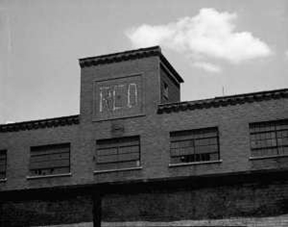
Reo, or REO, stood for Ransom E. Olds; and
was the company he founded when he left what later became the Oldsmobile
Division of General Motors. Although he originally built
automobiles, by the time World War Two arrived the company was only building trucks. Reo was an
important source of employment on the south side of Lansing, MI, where I grew up. Reo's
plant was located at South Washington and Baker Streets in Lansing.
The plant was torn down in the 1980's after Diamond Reo went out of
business. My grandfather took part in one of the few non-violent
sit-down strikes that happened in the US auto industry in the era of
unionization. The four-week strike started on March 10, 1937.
My grandmother, along with other workers' wives, passed food and supplies through the factory windows
to keep their men going. After the
strike, my grandfather got a job at Lansing Fisher Body. The move turned
out to be timely, as Reo went bankrupt in 1939, closing the plant for a year.
In looking at the World War Two product
information below, it is apparent that Reo was not producing vehicles
at its 50,000
units of annual capacity. This was a problem that bedeviled the company
for many years, and finally led to its demise in 1975. I remember,
as a teenager, walking past 'The Reo', as we called it, on my way to
downtown Lansing. At that time, the Vietnam War was in full swing
and Reo was producing many M35 Army 2.5-ton 6x6 trucks for that conflict. Probably
without these, it would have gone out of business earlier.
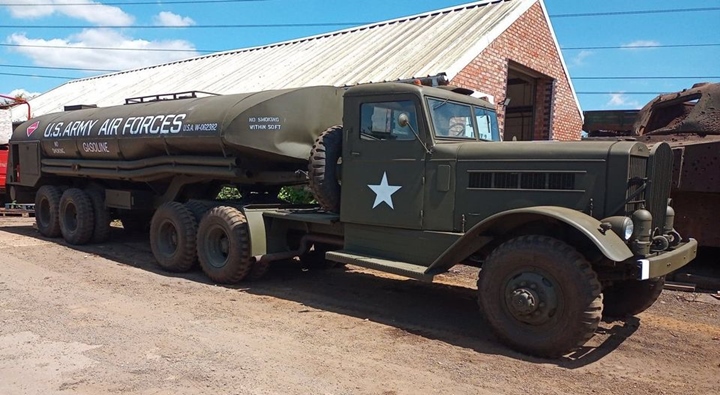
What a great looking
Reo-built World War Two Model 29XS F-1 refueling tractor! This
extremely rare Reo-built truck is owned by Ian Hughes in the United
Kingdom. Reo built 1,740 of the 29XS for the USAAF which were
used to pull large fuel trailers as shown here. Below are a
series of photos of the vehicle both in action at an outside event
and in a garage. These photos allow one to view this great
Lansing, MI-built truck that helped win World War Two by keeping
USAAF aircraft supplied with fuel. Image courtesy of
Mick Wilson via Jeff Lakaszcyck added 2-29-2024.
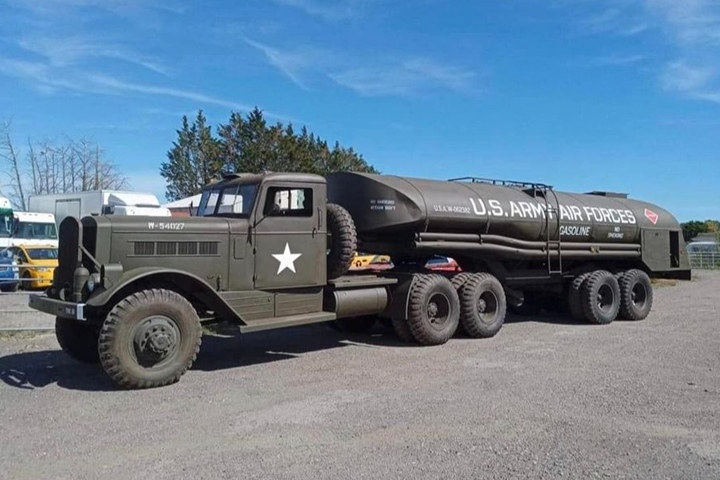
Image courtesy of
Mick Wilson via Jeff Lakaszcyck added 2-29-2024.
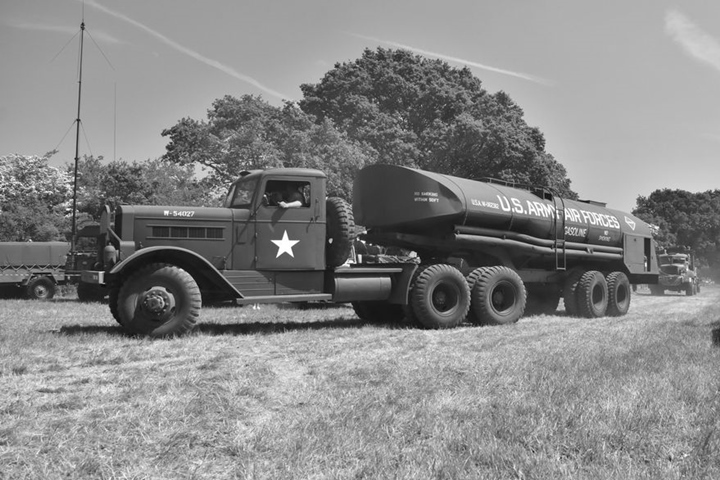
Image courtesy of
Mick Wilson via Jeff Lakaszcyck added 2-29-2024.
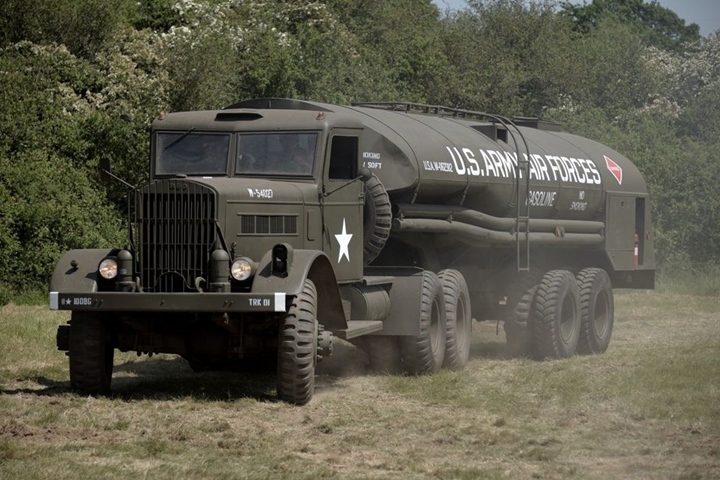
Image courtesy of
Mick Wilson via Jeff Lakaszcyck added 2-29-2024.
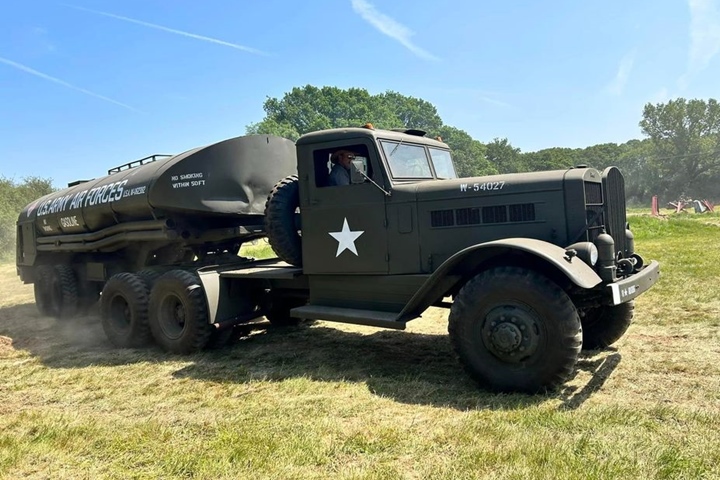
Image courtesy of
Mick Wilson via Jeff Lakaszcyck added 2-29-2024.

Image courtesy of
Mick Wilson via Jeff Lakaszcyck added 2-29-2024..
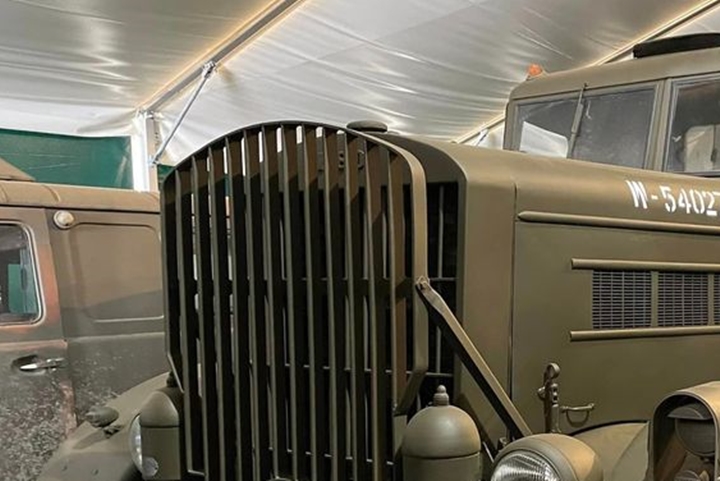
This enlargement of
the above photo shows the name "Reo" on the front. Image
courtesy of
Mick Wilson via Jeff Lakaszcyck added 2-29-2024.
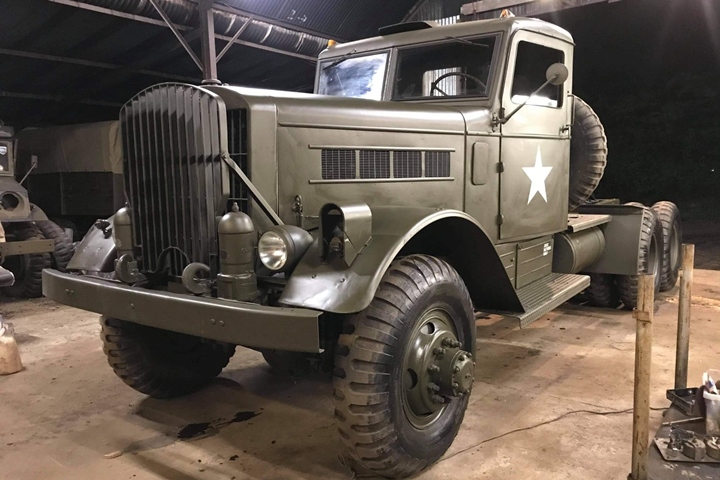
Image courtesy of
Mick Wilson via Jeff Lakaszcyck added 2-29-2024.

Image courtesy of
Mick Wilson via Jeff Lakaszcyck added 2-29-2024.
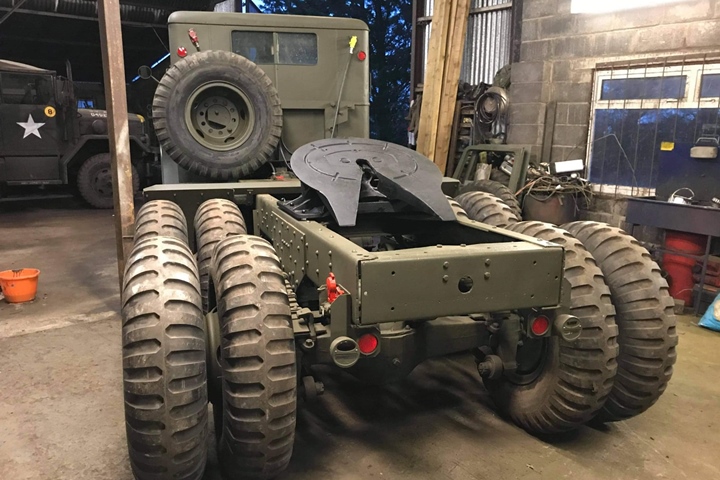
Image courtesy of
Mick Wilson via Jeff Lakaszcyck added 2-29-2024.
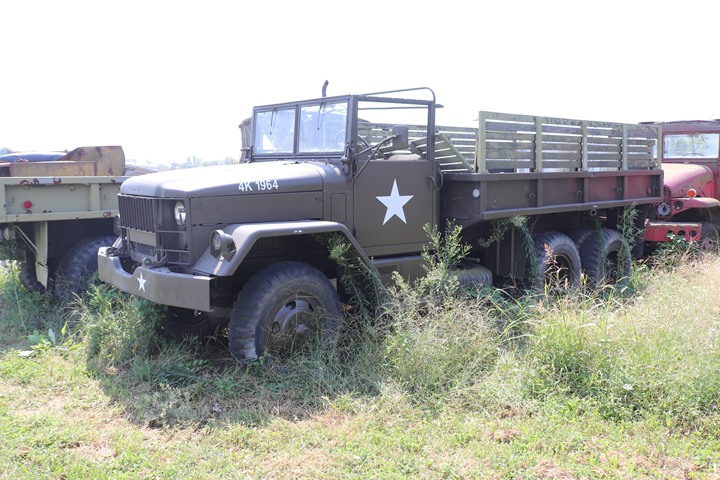
On August 31, 2019 I visited the World
War Two reenactment at the Indiana Military Museum in Vincennes, IN.
While there I walked down the fence line where the museum stores several vehicles. When I walked up to this one, I had a
hunch that this was a Lansing-built M35 built at the former Reo
plant as part of White Motors. There was no logical reason I
should know this, as all of the M35s look alike. Author's
photo added 9-11-2019.
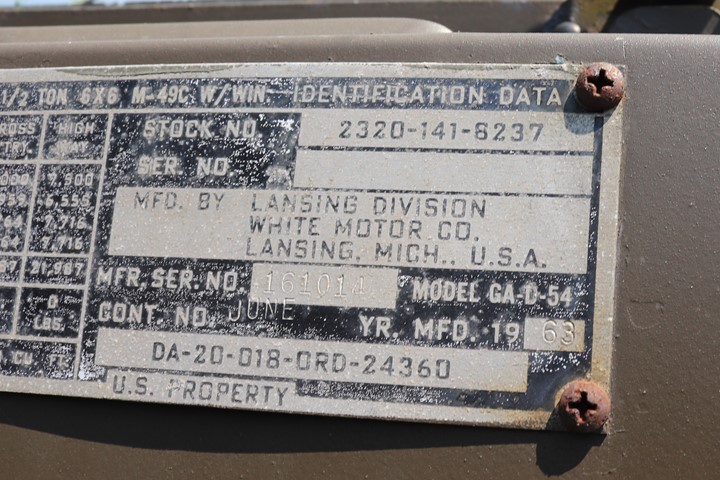
But I was right! It was built at
the former Reo plant on Washington Avenue in 1963 when I was in
junior high school. It is possible this is one of the many
M35s I saw come off the assembly as I walked by the plant.
Author's photo added 9-11-2019.
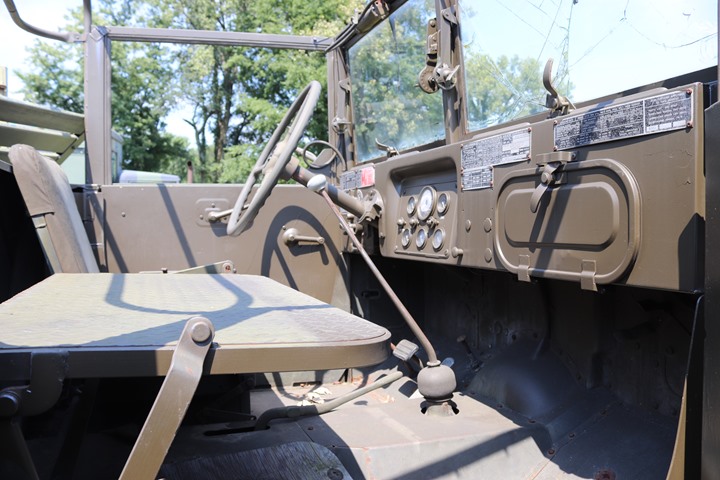
The Indiana Military Museum has a large
multi-bay building for restoring vehicles. Hopefully, this
Lansing-built M35 will go through the building in the near future so
it can be put on display in the museum. It is in very good
shape for being 56 years old. Author's photo added 9-11-2019.
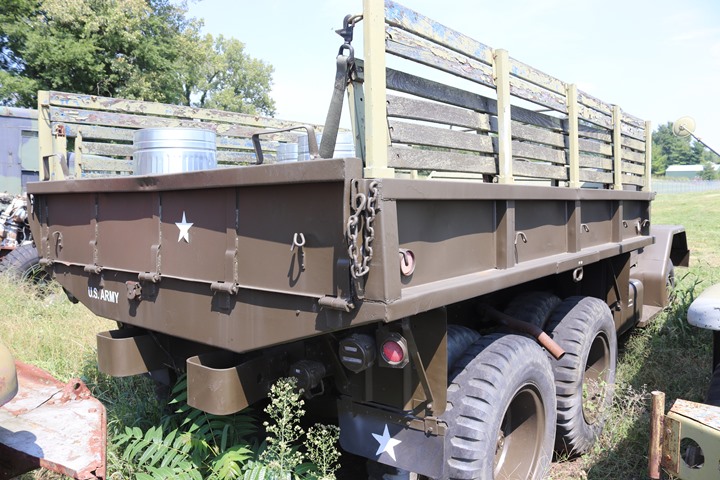
Author's photo added 9-11-2019.
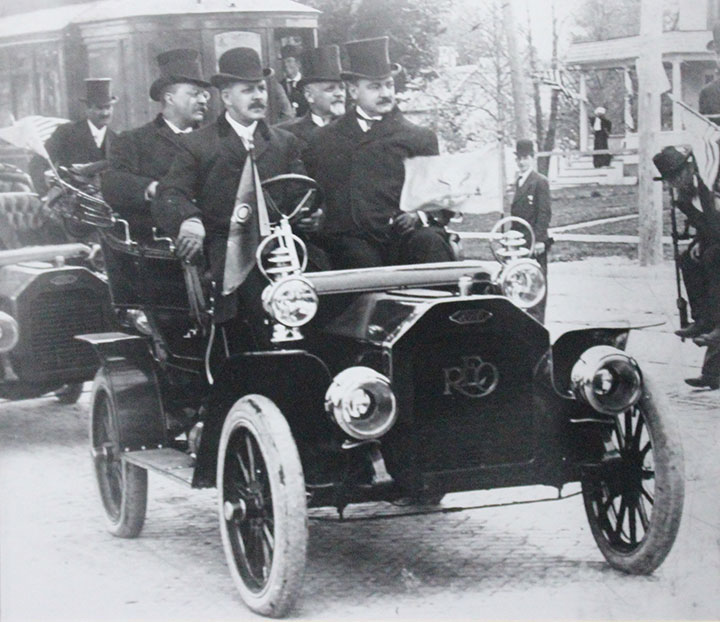
It's 1907 and R.E. Olds is driving President
Teddy Roosevelt in a Reo to Michigan State Agricultural College in East
Lansing (Now Michigan State University) so he can deliver the
commencement speech. Photo added 4-30-2015.
The next series of photos show the progression
of the design and technology of the Reo truck between 1912 and 1938.
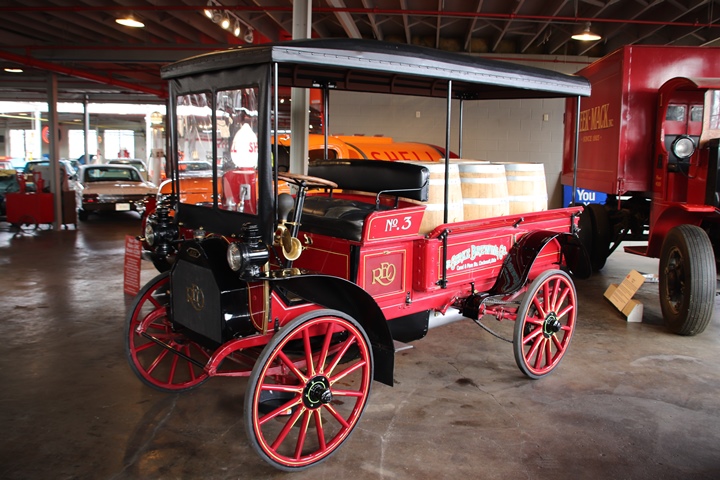
This is a 1912 Reo truck and is the oldest
one I have found on display. It was on loan at the National Auto
and Truck Museum in Auburn, IN. Author's photo added 1-22-2021.
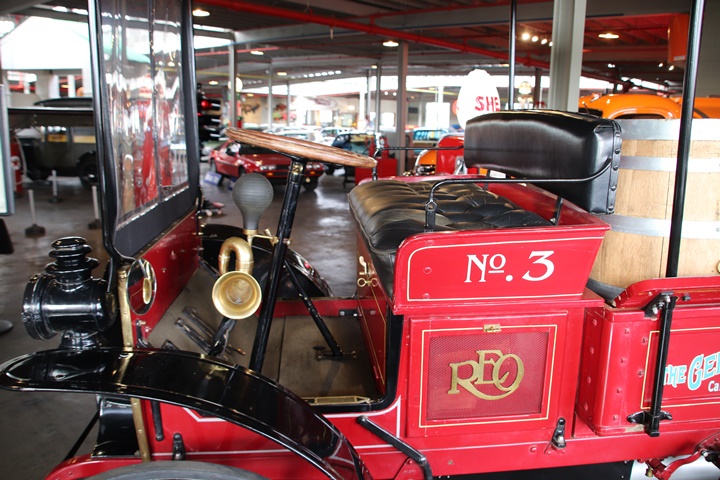
Author's photo added 1-22-2021.
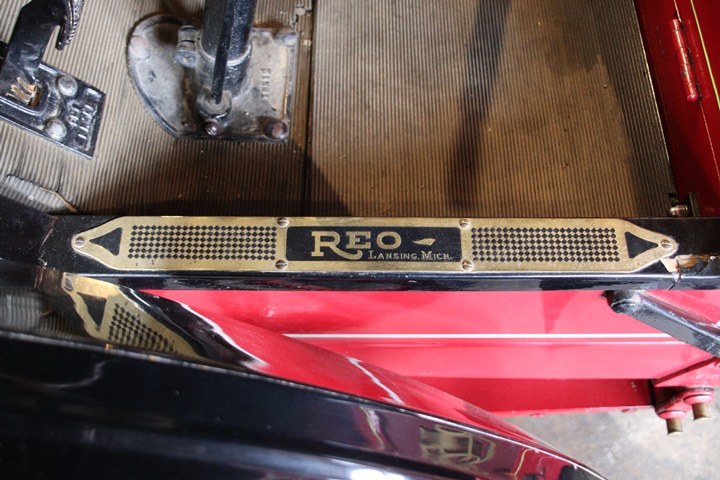
Author's photo added 1-22-2021.
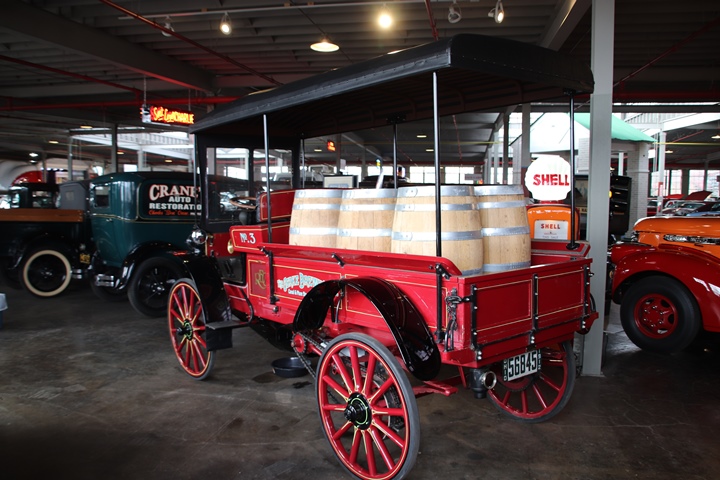
This Reo truck was used to distribute kegs
of beer in Cincinnati, OH. Author's photo added 1-22-2021.
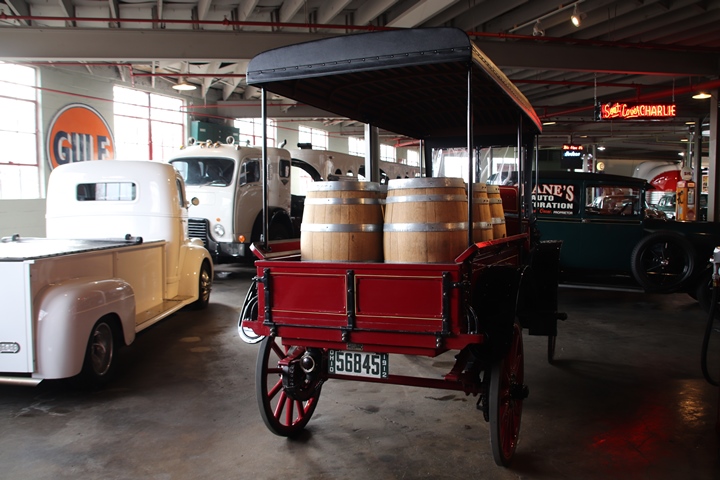
The truck has a 1912 Oho license plate.
Author's photo added 1-22-2021.
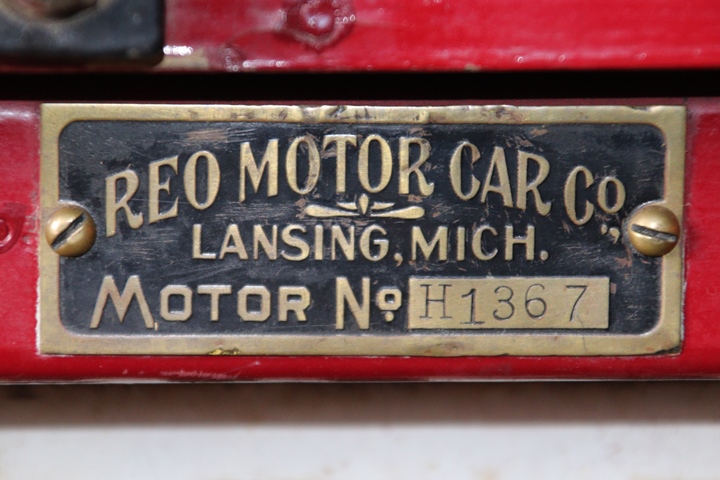
Author's photo added 1-22-2021.
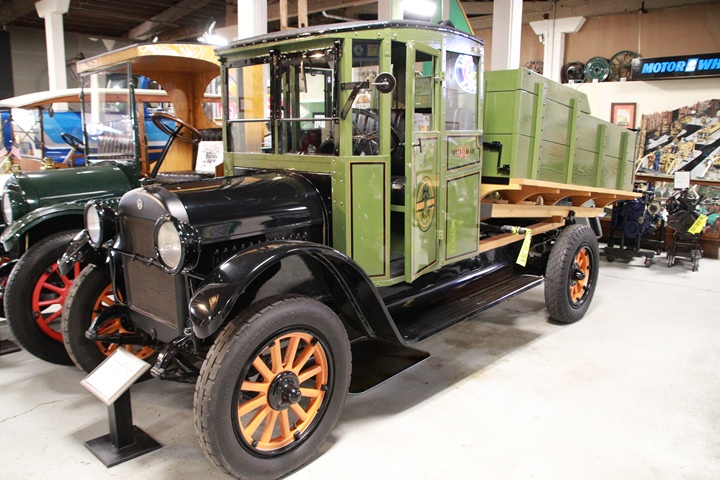
This 1925 Reo Speedwagon dump truck is a new
addition to the R.E. Olds Transportation Museum in Lansing, MI.
Author's photo added 9-7-2021.
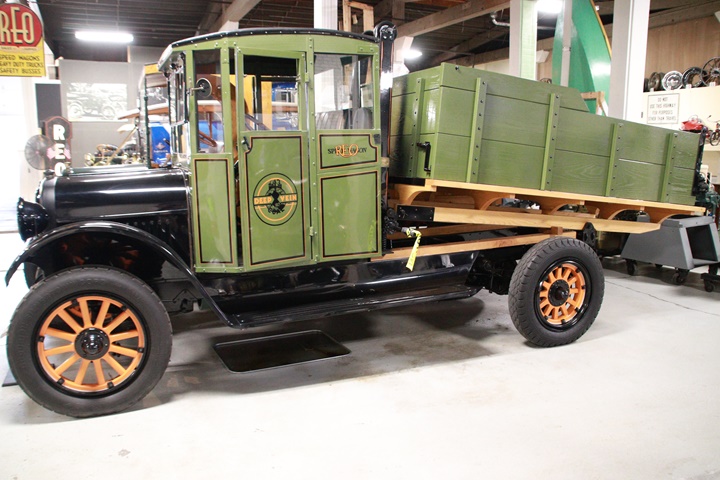
Author's photo added 9-7-2021.
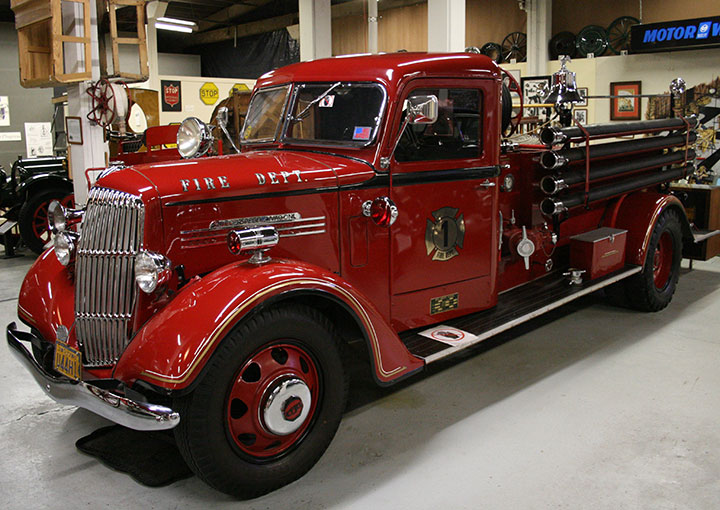
A 1938 Reo Speed Wagon at the RE Olds Museum
in Lansing, MI. My grandfather worked at 'The Reo' in 1938, so he
contributed to the building of this in some form or manner. Back in the old days, they sure knew how to build a
good looking fire truck. Now you know where the band REO Speedwagon got its name. Author's photo.
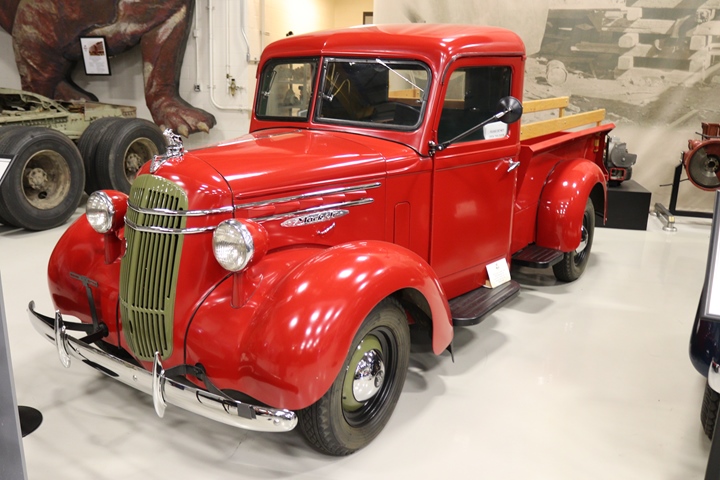
In June 2019, I photographed this 1937 Mack
Jr. 1/2-ton pickup truck at the Mack Museum in Allentown, PA. Why
have I placed this photo on the Reo page? Because this is actually
a Reo pickup truck with a Mack nameplate on it that Reo built in
Lansing for Mack. This was Mack's attempt to enter the light truck
market without having to commit limited engineering and manufacturing
resources to the product. Reo produced the Mack Jr. from 1936 to
1938, when manufacturing stopped due to lack of demand. Note the
similarity to the 1938 Reo Speed Wagon in the above photo.
Author's photo added 7-3-2020.
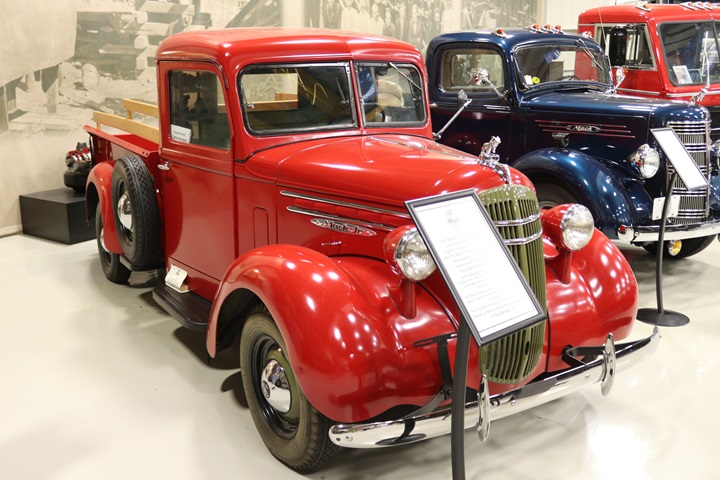
It may say Mack Jr. on the outside and have
the Mack Bulldog on the hood, but underneath it is a Reo. Author's
photo added 7-3-2020.
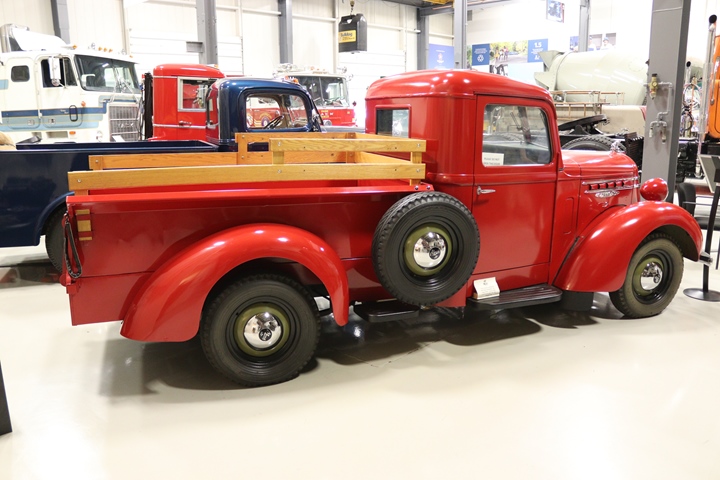
Author's photo added 7-3-2020.
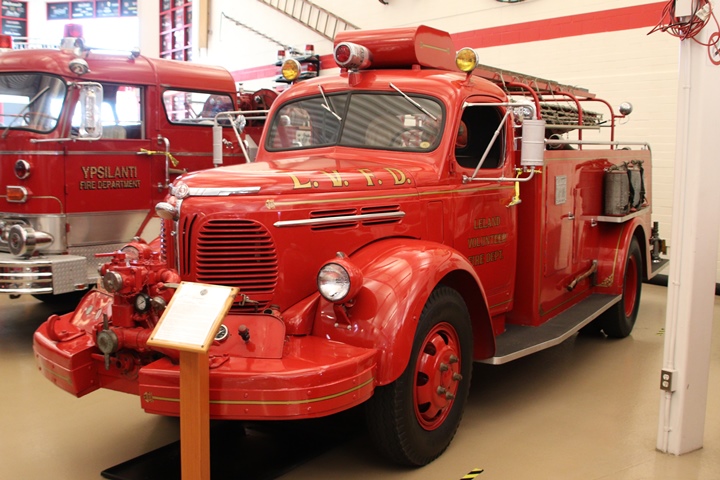
This 1947 Reo served with the Leland, MI
Volunteer Fire Department from 1948 to 1971. The chassis was
purchased at a local Reo dealership and the pump and other fire
equipment from the W.S. Darley Company in Chicago, IL. Due to
post-World War Two steel allocations, the volunteer firemen needed some
political assistance to obtain the steel for the body. They then
constructed their own fire engine on the Reo chassis. Today it is
on display at the Michigan Firehouse Museum in Ypsilanti, MI. Author's photo added
2-23-2022.
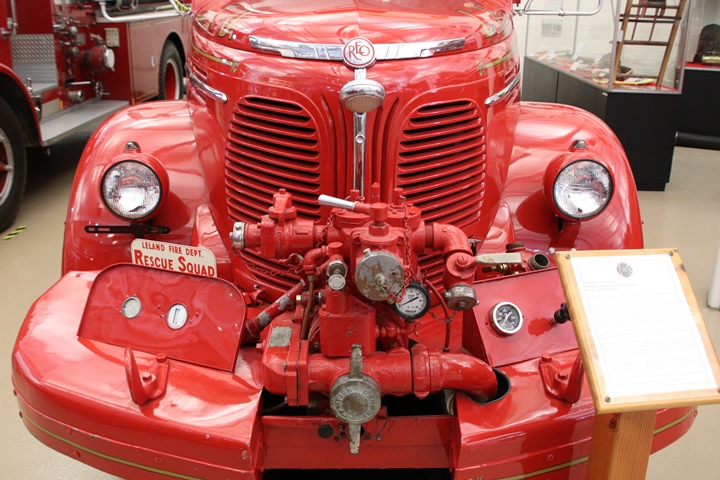
Author's photo added 2-23-2022.
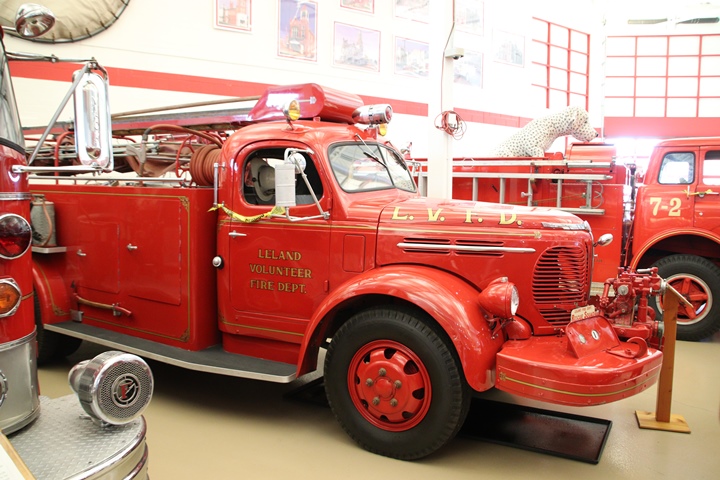
Author's photo added 2-23-2022.
Reo in World War Two: Reo is best
known for the trucks it built during World War Two
because before and after World War Two Reo was a truck manufacturer.
However, trucks were one of several products the company built during
World War Two. Examination of the Reo corporate records at the
Michigan State Archives in East Lansing, MI show that Reo produced
several other important products, along with machining parts for other
war goods manufacturers.
Reo records provide an insight into what other
companies during World War Two may have been working on besides their
main product line. In my research on other companies, I have long
questioned whether the limited existing data tells the complete story of
industry supplying World War Two. The most complete and comprehensive
set of records that are readily available is
the "Summary Report of Acceptances, Tank-Automotive Material,
1940-1945." The Summary is one of my most important documents to determine how many vehicles a company built during World War Two.
However, it does have its limitations. It only comprehends the
number of vehicles accepted by Army Ordnance during World War Two.
As Table 2 shows, in 1942 Reo built trucks for a least ten other American
military organizations and one private company. None of this
information is comprehended in the "Summary Report of Acceptances,
Tank-Automotive Material, 1940-1945." The U.S. Navy had several
departments ordering trucks that they needed for their operation.
Without the Reo records at MSU, this information would have been lost.
If Reo was building trucks for the over ten
different organizations in 1942, there is no reason to think that other
truck manufacturers weren't also doing the same. The Navy and
other entities would have been placing similar orders with other truck
manufactures to be able to acquire the massive number of vehicles needed
to fight a global war.
The U.S. Navy was Reo's main customer during World War Two. While the Navy purchased 3,777 trucks from Reo, it
also purchased 1,424,473 aerial bomb fuzes from the company.
This was Reo's unknown and confidential product of World War Two.
In "Reo Produces for War" shown below, there is a portion of a page that
says "Censored." This was the Navy aerial bomb fuze production.
The Navy considered this to be a sensitive product and Reo was not able
to publicly say anything about it. Of 3,000 employees working at
Reo in 1943, 844 (or 28%) were working a three shift operation making fuzes
for the Navy.
Reo also made use of its idle machine tools
and machined parts for multiple companies, including several that were making
airframe parts for B-17s and B-26 bombers. Other customers included Food Machinery Company (FMC) and Standard Spring Companies.
Reo built 41,920 bogies for tracked landing craft and 25,339 4-ton truck
axles for Standard Spring, which was sub-contracting work out for
the Timken-Detroit Axle Company. Due to a shortage of Clark
Equipment Company and Warner Gear transmissions for use in the GMC CCKW
and Studebaker US6 2-1/2-ton 6x6 and 6x4 series trucks, Reo was
contracted by the U.S. Army to tool up and produce transmissions.
As of September 1944, the company was contracted to build 22,814
transmissions.
Reo, as the Diamond-Reo Division of White Motor,
went out of business in 1975. Instead of the records being put in
a dumpster and sent to a landfill, like has happened with so many other
companies that closed, someone in Reo made sure that the records
were preserved. They ended up five miles to the east, in Conrad
Hall at the Michigan State University Archives. For me, being able
to go through the records and learn the complete story of Reo during World War Two brings me full circle, as my
grandfather worked at Reo before World War Two, and it was one of
several local factories located in the neighborhood in which I grew up.
Also, Michigan State is where I went to college.
Reo Motor Car Company Non-Military World
War Two Era Trucks:
One overlooked aspect of World War Two is the number of civilian
or non-military trucks that were built. While automobile
production in the United States came to a halt in February 1942,
civilian truck manufacturing was allowed by the War Production Board on
a limited basis. After all, trucks were needed to move war
supplies throughout the supply chain. However, the information on non-military truck
volumes built between 1941 and 1945 is
extremely limited. While there are no available production numbers of Reo-built
civilian trucks during the war, the two pages below from
the 1945 annual report show the types of trucks that the company built for this market.
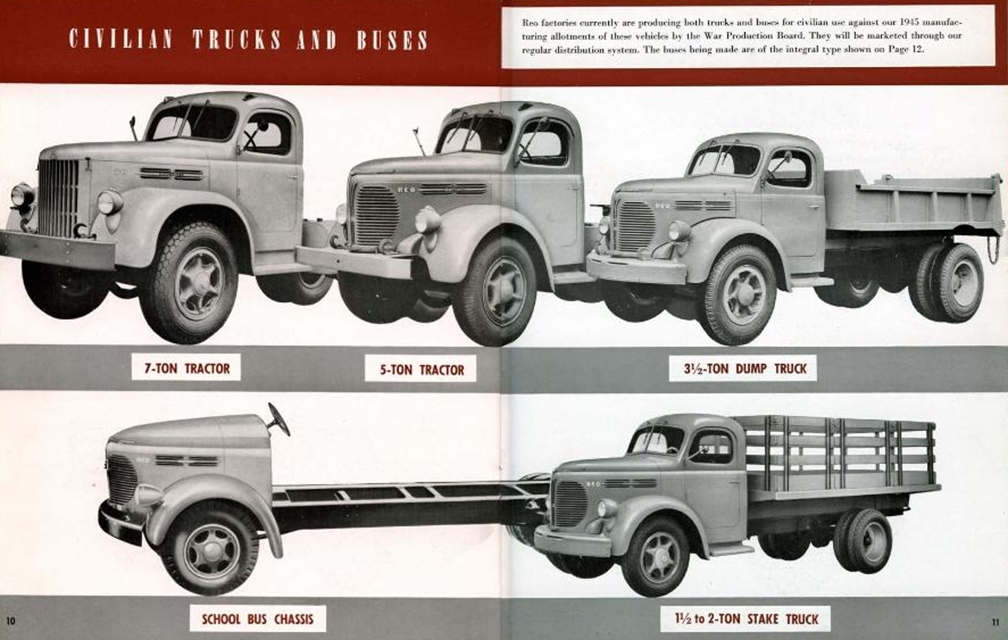
Image added 4-22-2020.
Reo Motor Car Company
World War Two Products:
29,800 Trucks and Buses, 1,424,473 Navy Bomb Fuzes, 41,920 LVT
Bogie Wheel Assemblies, 25,339 Four-ton 6x6 Heavy Duty Axles, 22,814
Transmissions for 2-1/2-ton trucks, B-26 Tail Assembly Spars, B-17
Outer Wing Components, Aircraft Radial Engine
Starter Parts, Aircraft Engine Parts
Trucks: 29,800 total trucks of various sizes.
This was Reo's signature product of World War Two.
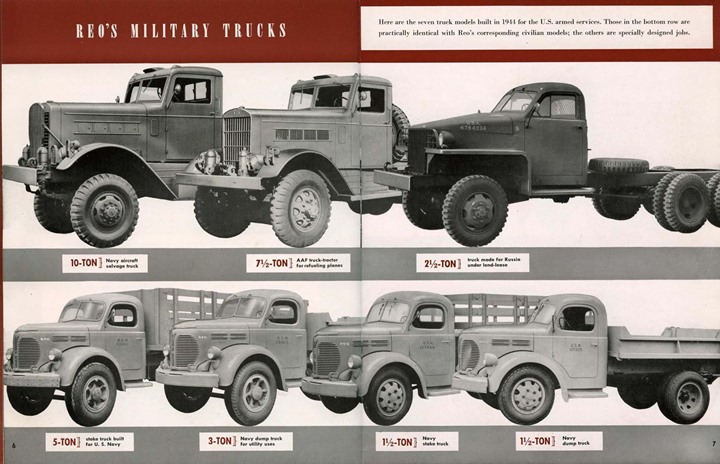
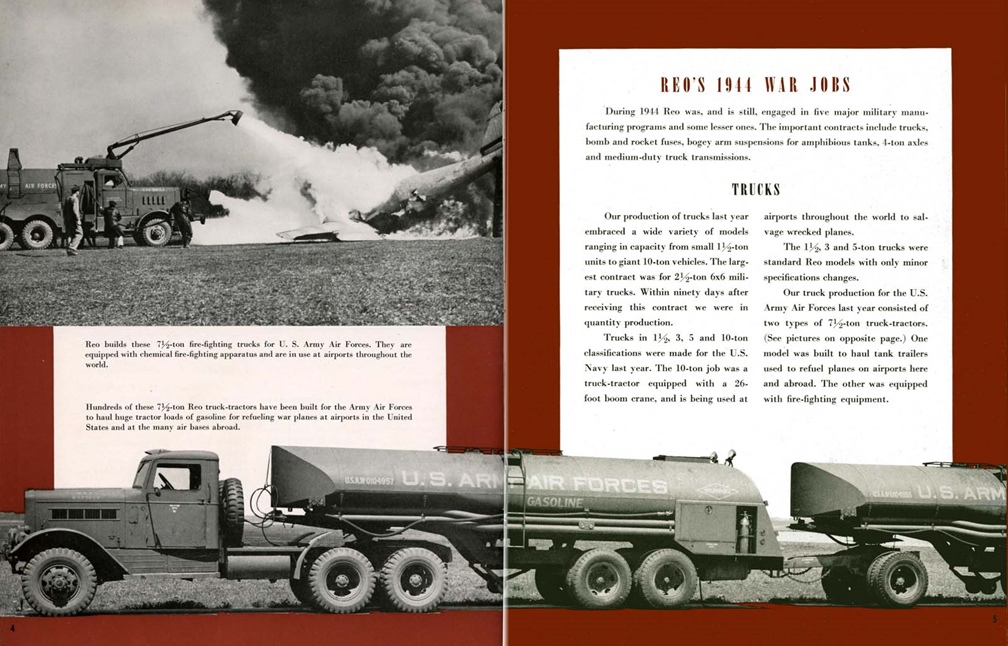
Table 3, line 12 shows that Reo built 2,318
7-1/2-ton trucks for the Army Air Force during World War Two.
Image added 4-22-2020.
Table 1 - Reo War World War Two Trucks
Accepted by Detroit Ordnance, US Army
The information below comes from
"Summary Report of Acceptances, Tank-Automotive Material,
1940-1945"
Published by Army Services Forces, Office, Chief of
Ordnance-Detroit, Production Division, Requirements and
Progress Branch
January 21, 1946. |
|
Line Number |
Type |
Reo Model |
1940 |
1941 |
1942 |
1943 |
1944 |
1945 |
Total |
|
1 |
2-1/2-ton 6x6 without winch (Studebaker US6) |
US6 |
|
|
|
|
13,004 |
9,200 |
22,204 |
| 2 |
2 1/2-ton 4x2 Cargo |
21HHHS |
|
40 |
|
|
|
|
40 |
| 3 |
2 1/2-ton 4x2 Dump |
21XHHS |
157 |
104 |
|
|
|
|
261 |
| 4 |
5-ton 6x4 Cargo |
23XHHRS |
|
1 |
|
|
|
|
1 |
| 5 |
5-ton 4x2 Dump |
23BHRS |
6 |
|
|
|
|
|
6 |
|
8 |
20-ton 6x4 Tractor (Federal 604) |
28XS |
|
|
700 |
|
|
|
700 |
| |
Total |
|
163 |
145 |
700 |
|
13,004 |
9,200 |
23,212 |
|
Number of trucks not
comprehended in Tables 2 and 3. Add Lines 2, 3, 4 and
5. Entered on Line 1 of Table 5. |
308 |
*The 2-1/2 ton 6x6 Trucks
were license built Studebaker US6s for Lend-Lease for the Soviet Union.
**The 20-ton 6x4 Tractors were copies of the Federal 604. This was
Reo Model 28-XS and was powered by Cummins HB600 Diesels, of which 190
went to the Soviet Union under Lend-Lease.
Author's Note
and Disclaimer: The Detroit Office
of Ordnance of the U.S. Army was the primary purchasing entity for vehicles for the U.S. Army during WWII. It also purchased
vehicles for the USMC, US Navy, and for Lend-Lease. However,
there were other organizations that also purchased vehicles
including the Army Corps of Engineers, U.S. Army Air Force, U.S.
Army Signal Corps, Navy Bureau of Ordnance, Navy
Bureau of Aeronautics, and foreign countries making direct
purchases.
I insert the above disclaimer on all my
web pages, where I use information on acceptances by Army Ordnance.
The information in the tables below makes Reo a poster child for why I
do this. I was able to access the Reo corporate records at the
Michigan State Archives in East Lansing, MI, and found that in 1942, Reo had
orders for trucks from many different organizations that are not
comprehended in the table above. Army Ordnance records from World
War Two do not capture all of the vehicles made by American companies
during the war. If Reo had orders like those below, no doubt so
did other truck and vehicle manufacturers. The number of trucks
built during World War Two was more than the "official" count given by
Army Ordnance.
Table 2 - 1942 Reo
Truck Orders
Five different departments of the U.S. Navy, three different
departments of the Army, the Treasury Department, the
Interior Department and the Marine Corps ordered trucks from Reo
in 1942. There is also a private company and three
listings that refer to Lend-Lease.
There are similar orders for Navy
and Army Air Corps/ Army Air Force
trucks in both this Table and Table 3. Table 3 no doubt
comprehends trucks in this table, as it is orders for only one
year. Table 3 encompasses the entire war effort. |
|
Line Number |
Number Ordered |
Reo Model Number |
Type |
Customer |
Contract No. |
Comments |
| 1 |
25 |
22-C |
Chassis and Cab |
Lend-Lease |
DA-TPS-9814 |
These
were probably ordered by the British Purchasing Commission. |
| 2 |
25 |
21-C |
Chassis and Cab |
Lend-Lease |
DA-TPS-9814 |
Same
as above. |
|
3 |
280 |
23HHXH |
Stake
and Dump |
Bureau of Yards and Docks |
NXSY-17341 |
Comprehended in either
Lines 1, 3 or 4 of Table 3. |
|
4 |
500 |
23CH |
Stake |
Bureau of Aeronautics |
NXS-6711 |
Comprehended in either
Lines 1, 3 or 4 of Table 3. |
|
5 |
200 |
23HH |
Dump |
Bureau of Aeronautics |
NXS-6711 |
Comprehended in either
Lines 2 or 5 of Table 3. |
|
6 |
95 |
25XS |
Stake |
Navy-Washington |
NXS-66 |
Comprehended in either
Lines 1, 3 or 4 of Table 3. |
|
7 |
700 |
28XS |
Tank Transport |
British Lend-Lease |
W-3989-QM-11615 |
These trucks are comprehended
on Line 8 of Table 1. |
| 8 |
1,740 |
29XS |
Fuel
Service |
U.S.
Army Air Corps |
W-535-AC-27790 |
|
|
9 |
150 |
119XHS |
School Bus |
Kaiser Company-Peterson |
No
Information |
Kaiser used these to get its
employees to work and transport them around the huge shipyards
building Liberty ships. |
| 10 |
100 |
19BHS |
Cab
and Chassis |
Treasury Dept. |
DA-TPS-10240 |
These
were ordered by the Treasury Dept. for the Australian
Government. |
| 11 |
8 |
19XS |
Chassis and Cab |
Treasury Dept. |
ER-T98PS-1395 |
Same
as above. |
|
12 |
37 |
121XHHS |
Buses-School |
Navy |
NOS-92774 |
|
|
13 |
2 |
56T |
Buses |
Navy |
NOS-90916 |
|
| 14 |
5 |
19XHS |
Chassis and Cabs |
Navy |
NOS-96585 |
|
| 15 |
1 |
19BHS |
Chassis and Cabs |
Navy |
NOS-96585 |
|
| 16 |
6 |
20XS |
Chassis, Stake Body |
Dept.
of Interior |
1BP-2684 |
|
| 17 |
9 |
21XHS |
Chassis, Dump Body |
U.S.
Engineers |
W-461-ENG-9828 |
|
|
18 |
115 |
20XHHRS |
Chassis, Dump Body |
Marine Corps |
NON-30870 |
|
| 19 |
1 |
23XHHRS |
Chassis, Dump Body |
Quartermaster Corps |
W-398-QM-9394 |
|
| 20 |
16 |
21XHHRS |
Chassis |
Marine Corps |
NON-29692 |
|
| 21 |
19 |
22BS |
Chassis |
Navy
Department |
NOS-82476 |
|
|
Total |
4,034 |
Total of all the truck and busses in
this table. |
| |
519 |
This is the total of trucks not
comprehended in either Table 1 or 3. These are considered
to be duplicates or subsets of trucks comprehended in those
tables. Entered on Line 2 of Table 5. |
There are no capacity ratings for the trucks in Table 2, while there
are no Reo Model numbers or Purchase Order numbers in Table 3 to
make positive identification of the same trucks being shown in each
table.
Table
3 -
Army, Army Air Corps and Navy Trucks produced by Reo during World War Two
From "Reo in the Fight for Freedom"
This was an end of the war oversize booklet published by
Timken in honor of the work Reo did in building trucks and
Timken axles.
Some the
trucks below are also comprehended in Tables 1 and 2. |
|
Line Number |
Number Built |
Type |
Comments |
|
1 |
594
|
1-1/2-Ton Navy Stake Trucks |
Comprehended on
either Lines 3, 4 or 6 of Table 2. |
|
2 |
594
|
1-1/2-Ton Navy Dump Trucks |
Comprehended on
either Line 5 or 18 of Table 2. |
|
3 |
743
|
3-Ton Navy Stake Trucks |
Comprehended on
either Lines 3, 4 or 6 of Table 2.
|
|
4 |
438
|
5-Ton Navy Stake Trucks |
Comprehended on
either Lines 3, 4 or 6 of Table 2. |
|
5 |
875
|
3-Ton Navy Dump Trucks |
Comprehended on
either Lines 5 or 18 of Table 2. |
|
6 |
300 |
5-Ton Navy Dump Trucks |
Comprehended on
either Lines 5 or 18 of Table 2. |
|
7 |
200
|
10-Ton 6x6 Navy Aircraft Salvage
Trucks |
|
|
8
-
Total |
3,744 |
Total Navy Trucks |
|
| |
|
9 |
22,204 |
2-1/2-Ton 6x6 Truck |
Comprehended on Line 1 of Table
1. |
|
10 |
700 |
Diesel Powered Tank Transporters |
Comprehended on Line 8 of Table
1. |
|
11 - Total |
22,904 |
Total Army Trucks |
|
| |
|
12 |
2,318 |
Army Air Force Truck Tractors
and Fire Trucks |
1,740
comprehended on Line 8 of Table 2. |
|
13 - Total |
2,318 |
Total Army Air Force Trucks |
|
|
14 - Grand Total |
28,966 |
This is the
traditional number normally associated with the number of
trucks Reo built during World War Two. Entered on Line
3 of Table 5. |
|
Table 4 - Reo Designed and
Built Protype Trucks in 1942 |
|
Quantity |
Type |
Comments |
|
1 |
6x4 Tandem-Drive
Heavy Duty Tractor |
|
|
1 |
6x6 2-1/2-Ton Truck |
This was the
Studebaker US6, Reo appears to have used the same number. |
|
2 |
6x6 Tractor Trucks
for Prime Mover for 155mm Guns |
|
|
2 |
4x4 1-1/2-Ton
Low-Silhouette Truck |
Reo Model Number
LS30F, USA Registrations 3114165-6, QMC Contract12362,
Ordnance Contract 2769 |
|
1 |
4x4 3-Ton
Low-Silhouette Truck |
Reo Model
NumberLS60F, USA Registration 4349038, QMC Contract12362,
Ordnance Contract 2769 |
|
Total = 7 |
Entered on Line 4 of
Table 5. |
Table 5 - Total of Known Trucks
and Buses built by Reo in World War Two
Table 3 is the primary data for this table. Data
from Tables 1 and 2 have been adjusted to remove any
duplicate accounting. To the best of my knowledge with
the data I have, this is the total number of military
vehicles built by Reo in World War Two. |
| Table
Number |
Number of
Trucks and Busses |
|
1 |
308 |
|
2 |
519 |
|
3 |
28,966 |
|
4 |
7 |
|
Total Number of Trucks and Buses built by Reo in World War
Two |
29,800 |

Four of the six trucks Reo built for the
U.S. Navy are shown in this photo from the 1945 Reo annual report.
The report indicates they were built in 1944. It is unknown
whether production extended to other years of World War Two.

This photo from the 1945 Reo annual report
shows the 10-ton 6x6 Navy wrecker, the 7-1/2-ton 6x6 tractor for the
Army Air Force, and the 2-1/2 ton 6x6 truck for the Soviet Union.
The report indicates they were built in 1944. It is unknown
whether production extended to other years of World War Two, except for
the 2-1/2-ton, which was also built in 1945 as shown below.
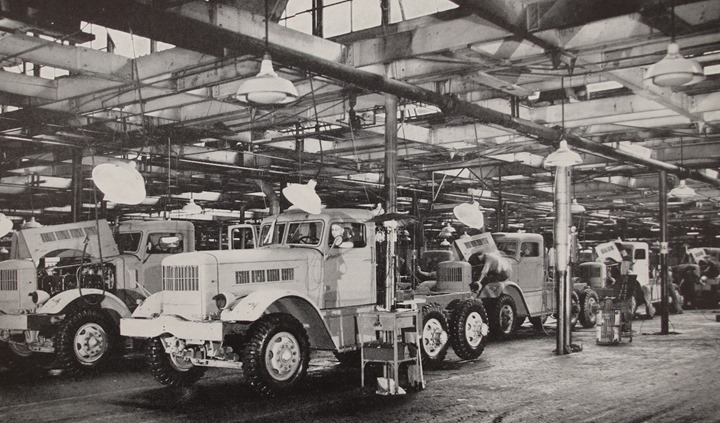
Reo ran two parallel truck lines during
World War Two. Image added 6-25-2020.
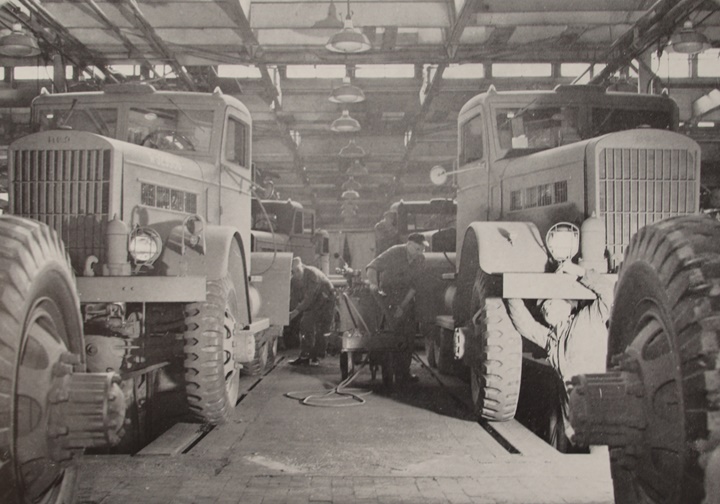
Image added 6-25-2020.
U.S. Navy Aerial Bomb and Death Charge
Fuzes:
1,424,473 Bomb fuzes. This product was considered confidential by the U.S.
Navy during World War Two. Information of this product can be
found in Reo World War Two correspondence and production records.
In the "Reo Produces for War" that is shown below, the Navy fuzes are
what is in the "Censored" section. All Reo could do was note it had
a secret product. The fuze contracts were a significant part of
what the company built during World War Two. Reo received a letter of intent from the
Navy in May 1941 and was in production December 1941.
|
Table 6 - Number of Reo Employees working on Navy Fuzes as of 6-1-1942
|
| Shift |
Number of
Direct Labor
Employees |
Number of
In-direct Labor Employees |
Total |
| 1 |
157 |
58 |
215 |
| 2 |
259 |
141 |
400 |
| 3 |
170 |
59 |
229 |
| Total |
586 |
258 |
844 |
Table 7 - Reo Navy Aerial
Fuze Production December 1941 through January 1942
Models 19, 21, 23, 27, 28, 29 |
| Time Period |
Quantity |
| 12-1941 |
3,030 |
| 1-1942 |
5,050 |
| 2-1942 |
8,080 |
| 3-1942 |
9,090 |
| 4-1942 |
13,130 |
| 5-1942 |
17,675 |
| 6-1942 |
14,140 |
| 7-1942 |
16,665 |
| 8-1942 |
18,180 |
| 9-1942 |
20,705 |
| 10-1942 |
31,840 |
| 11-1942 |
33,549 |
| 12-1942 |
59,538 |
| 1-1943 |
69,600 |
| Total |
320,272 |
|
Table 8 - 1944-1945 Reo Navy Aerial Bomb Fuze Production
|
|
Model |
Quantity |
Comments |
| 146 |
454,082 |
End
of Production (EOP) on 12-4-1944 |
| 157 |
272,304 |
|
| 159 |
30,000 |
Scheduled through October 1944 |
| 228 |
18,500 |
18,500 at EOP in March 1944 |
| 229 |
100,933 |
100,933 as of July production |
| 230 |
183,575 |
183,575 authorized as of July
1944 |
| 232 |
7,000 |
7,000
built as of the end of May 1944 |
| 233 |
3,577 |
3,577 total build as of July
1944 |
| 235 |
5,050 |
5,050 as of July
1944 |
| 243 |
27,180 |
|
| 244 |
2,000 |
30,000 scheduled thru 2-1946 Start of production July 1945
at with 2,000 |
|
Total |
1,104,201 |
|
|
Table 9 -Total Reo World War Two Navy
Fuze Production |
| Table |
Quantity |
| 7 |
320,272 |
| 8 |
1,104,201 |
| Total |
1,424,473 |
Other World War Two Products:
|
Table 10 - Reo
Contracts
from other Manufacturers |
| Company |
Product |
Quantity |
Comments |
| Hudson Motor Car
Company |
Machining B-26 tail
assembly spars |
|
Initial contract May
28,1941. Contract modified in 1943 when Hudson purchased
three milling machines to speed up production of the spars.
The machine process involved 67 different operations.
Hudson built 1,841 B-26 tail assemblies from Mary 1942 to
March 1944. |
| Martin Aircraft
Company |
Machining of
unknown parts. |
|
This
could also be for machining tail assembly spars, as the B-26 was
a Martin
design and it was the builder of the aircraft. This
contract ran all the way through 1945. |
| Murray Corporation |
Machining of unknown
parts for B-17s and B-24s. |
|
Murray Corporation
built B-17 outer wings early in World War Two, then built B-24
subassemblies and ailerons. |
| Hayes Manufacturing
Company |
Machining of unknown
parts. |
|
|
| Ford Motor Car
Company |
Machining of unknown
parts. |
|
|
| RCA Victor Division |
Machining of unknown
parts. |
|
|
| Douglas Aircraft |
Machining of unknown
parts. |
|
|
| Food
Machinery Corporation |
LVT
bogie wheel arm assemblies. |
41,920 |
This was
one of Reo's biggest World War Two products. The last
units were shipped on April 16, 1945. Another contracted 7,500 units
were never built. |
| Atlas Drop Forge,
Lansing Drop Forge, John Bean Manufacturing Company |
Heat treating of
parts |
|
In 1942 Reo was heat
treating parts for these and 20 other companies. There
were several more drop forges in Lansing during World War Two. |
|
Timken-Detroit Axle Company |
Machining of unknown
parts. |
|
|
| Standard Spring
(Subcontract agent for Timken-Detroit Axle Company.) |
Axles
for 4-ton 6x6 trucks |
25,339 |
Timken was unable to keep up with the demand for axles during
World War Two. Timken used Standard Spring to find
suppliers that could build axles for 4-ton 6x6 trucks.
Standard Spring gave Reo two contracts.
The first was for 6,000 sets of
axles. This included the fronts and the dual
rear axles for 18,000 units. These were ordered on
November 4, 1943, with start of production in May 1944. The
production rate was 500-800 sets per month or 1,500-2,400 axles
per month.
On a second contract, Reo
delivered 3,745 out of 4,002 front axles, when the order was
terminated on July 10, 1945. It also delivered 3,594 of
the 3,851 forward rear axles on order by the time the order was
cancelled on July 6, 1945.
|
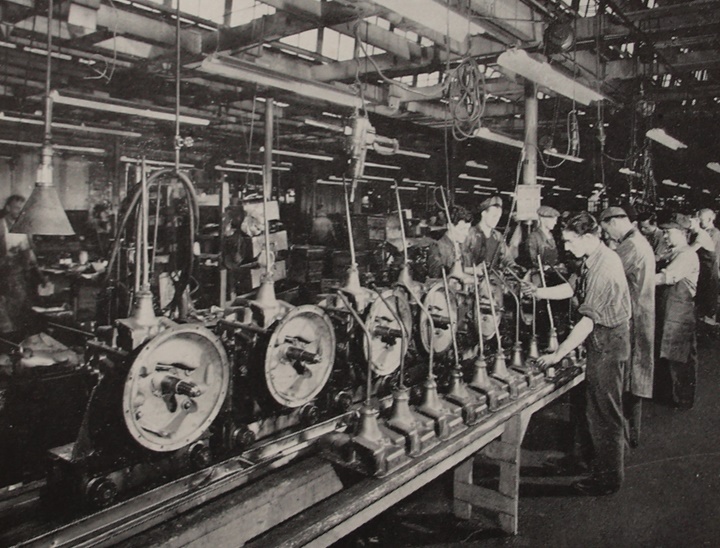
Transmissions for 2-1/2-ton trucks come down
the assembly line at Reo late in 1944. These were equivalent to
the Clark Equipment Company 204-VO and Warner Gear AS1-T93 transmissions.
Reo World War Two
Product Images: I have always wondered whether any of the
22,204 Reo-built Studebaker US6 2 1/2-ton 6x6 trucks had been sold as
war surplus at the end of hostilities. In April 2018 I found out
that
the answer is yes! The US6 shown below was built by Reo on July
26, 1945, and was sitting inside the fence at the site of the Tri-State Gas
Engine and Tractor Show in Portland, IN. It is no longer there. This has been in Jay
County, Indiana since 1977, and has been hiding in "plain sight" only 47
miles from my house. When I visited the Museum of the Soldier on
April 22, 2018, I was told about the truck and went over to see it.
I took the first three photos though the chain link fence
which surrounds the facility. The next four photos were taken by Brian
K. Williamson of Portland, IN, when he bid on the truck.
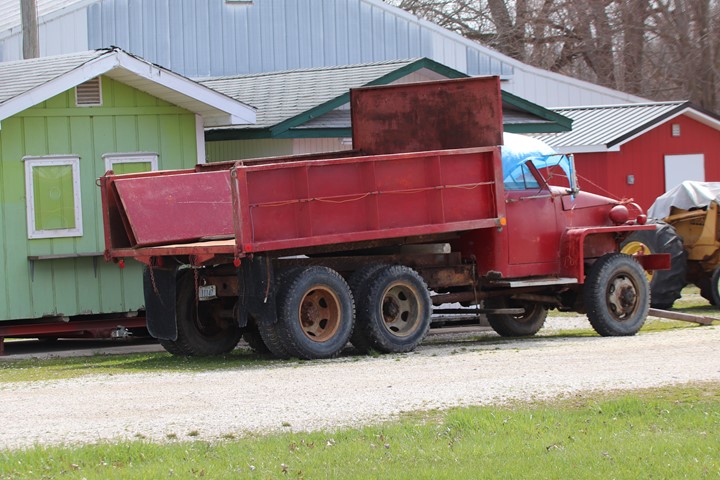
Author's photo added 4-24-2018.
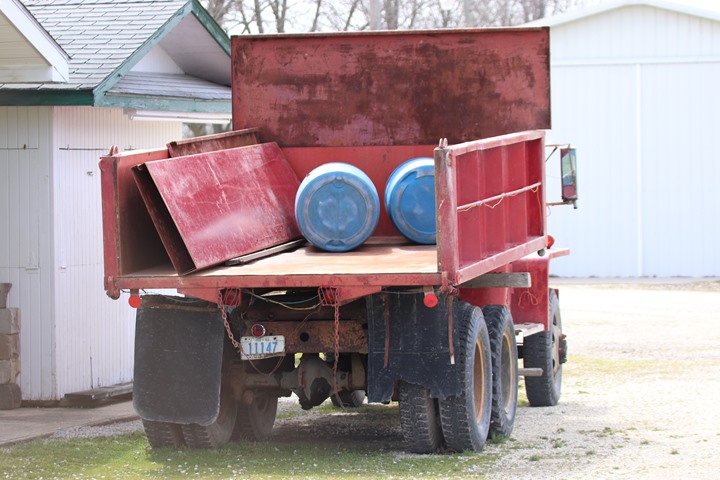
Author's photo added 4-24-2018.
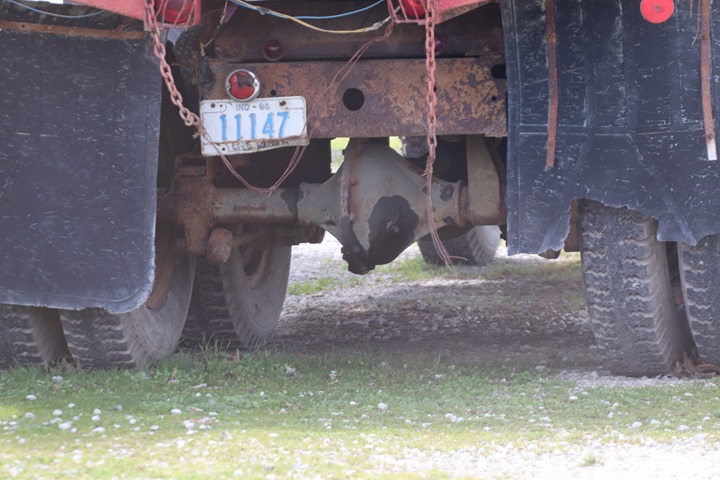
Author's photo added 4-24-2018.

Here is the Reo Motors data plate with date
of delivery of 7-26-1945. This late date saved it from going to
Russia under Lend-Lease, as the war in Europe was over and the war in
the Pacific would end in a month. Photo courtesy of Brian K.
Williamson added 4-24-2018.
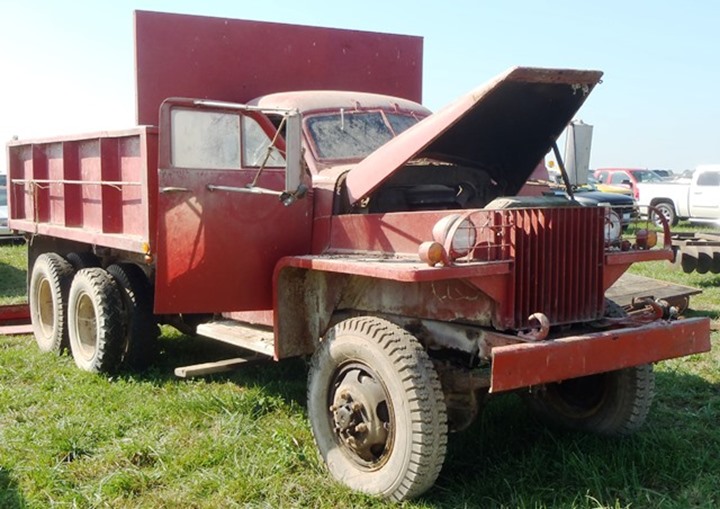
Photo courtesy of Brian K. Williamson added
4-24-2018.
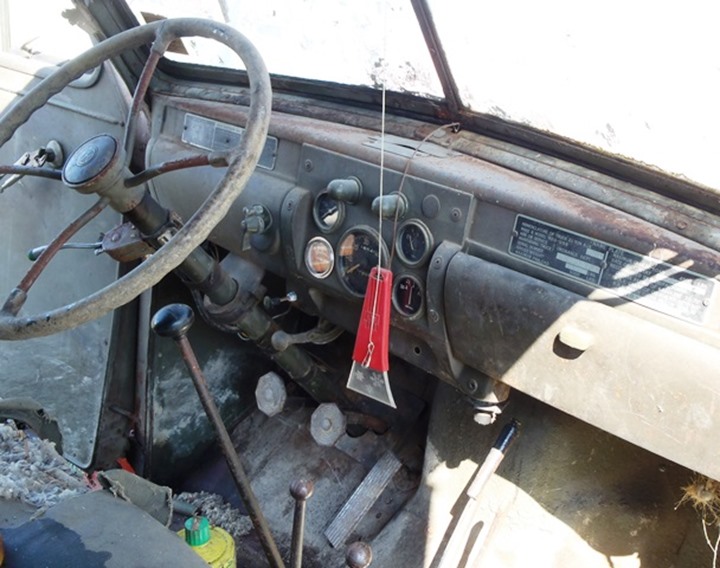
Photo courtesy of Brian K. Williamson added
4-24-2018.
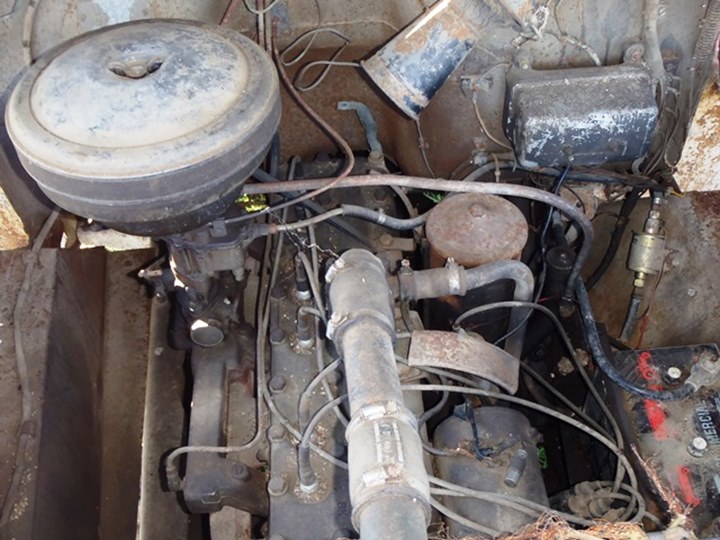
Photo courtesy of Brian K. Williamson added
4-24-2018.
There are also two 1945 Reo-built US6 trucks
at a location in Michigan. I was informed the weekend before that
there were only six Reo-built US6s still left. I do not think that
the two shown below were included in the number. These are then
numbers 7 and 8.
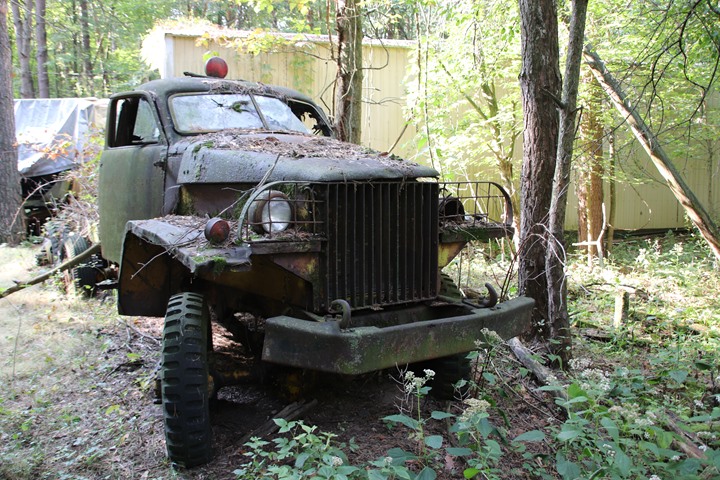
This Reo Serial Number 218557 has a delivery
date of 4-25-1945. It was purchased by the owner for a
parts vehicle, specifically for its front rear axle. The other Reo
truck needs to have that axle replaced. Author's photo added 9-26-2020.
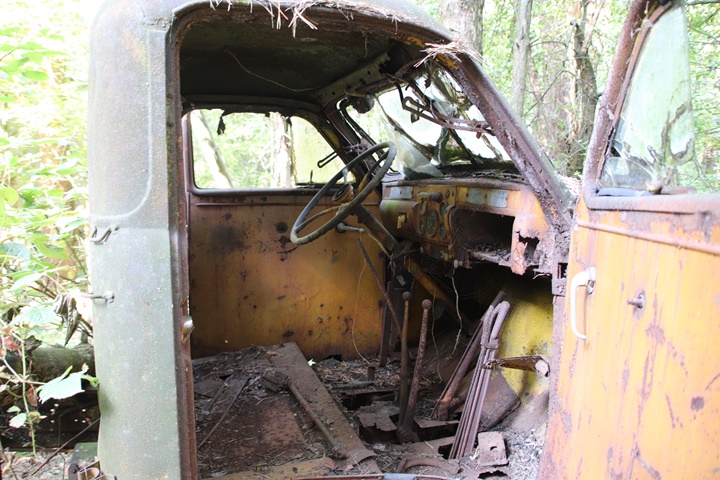
Author's photo added 9-26-2020.
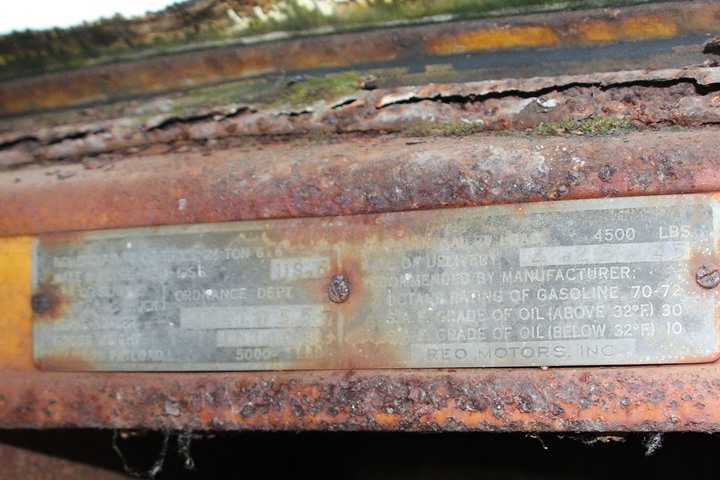
Author's photo added 9-26-2020.
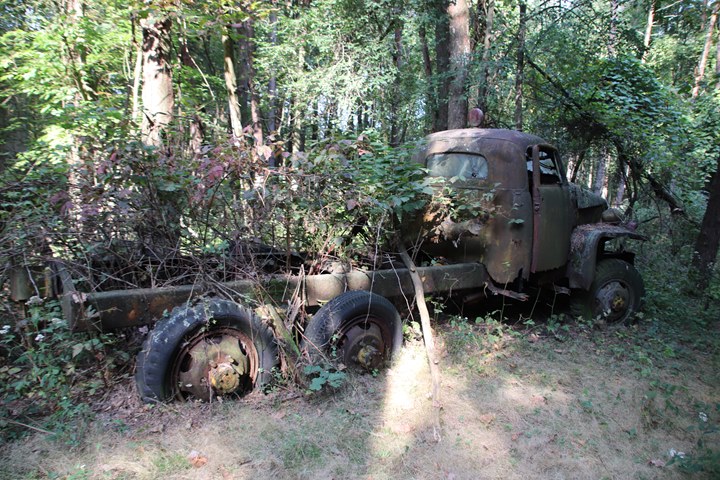
Author's photo added 9-26-2020.
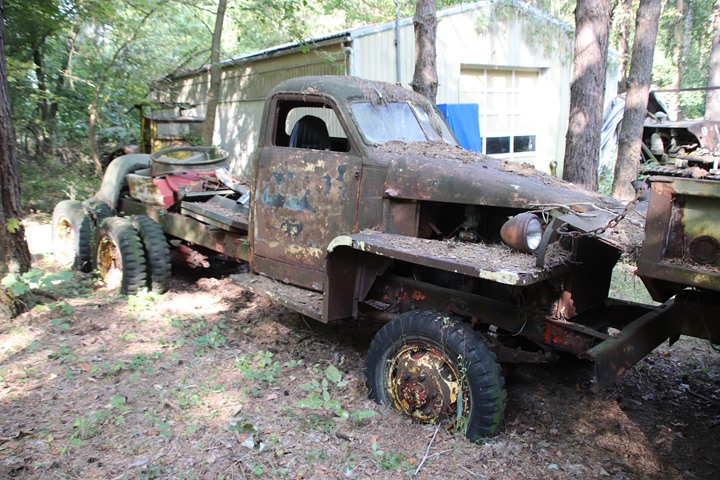
This is Reo Serial Number 222146 and has a
delivery date of 10-17-1945. Author's photo added 9-26-2020.
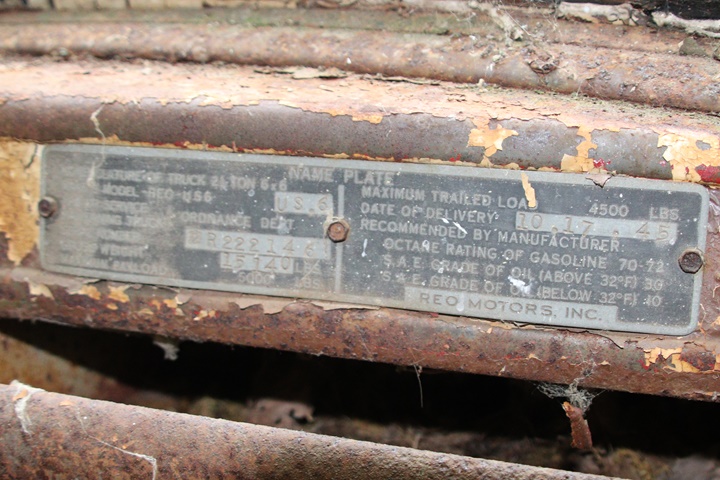
Author's photo added 9-26-2020.
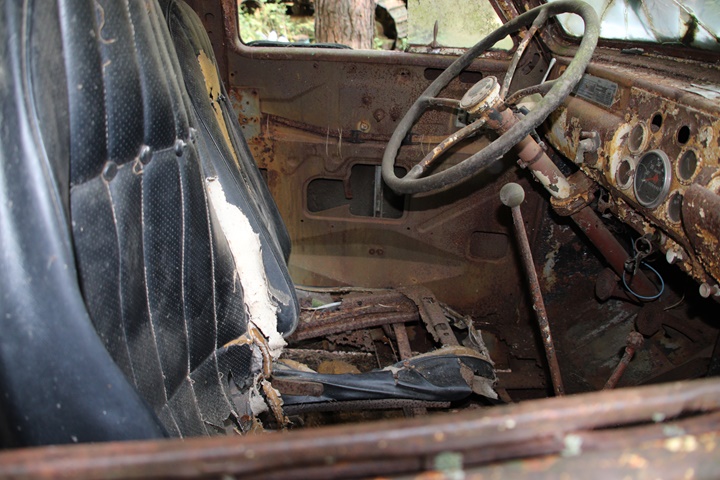
Author's photo added 9-26-2020.
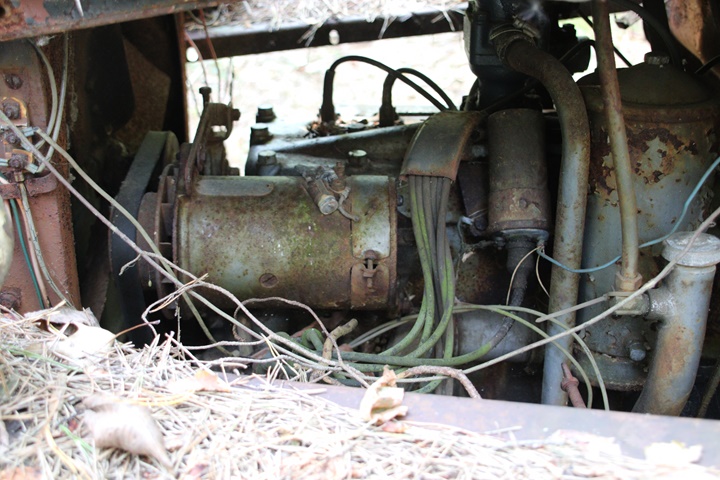
Author's photo added 9-26-2020.
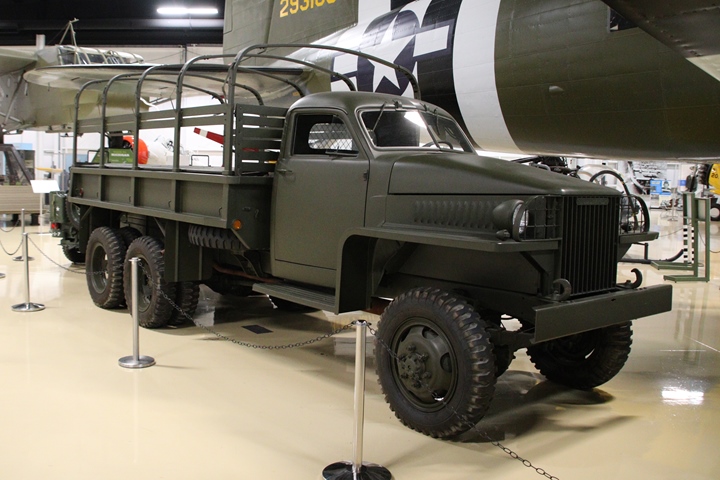
The trucks shown above and the other 22,201
2-1/2-ton 6x6 trucks Reo built during World War Two would have looked like this Studebaker US6 2 1/2-ton 6x6
when new. It is owned by the
Studebaker Museum. Author's
photo.
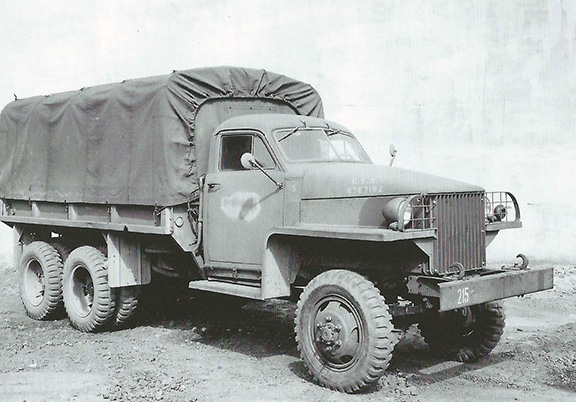
This is a 2-1/2-ton 6x6 US-6 truck built by Reo in Lansing. Photo
added 4-14-2015.
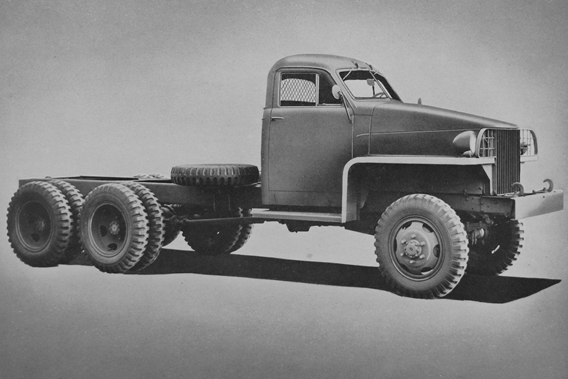
This shows the Reo US-6 without the cargo
body. Near the end of the war, many were shipped this way.
Photo added 12-29-2020.
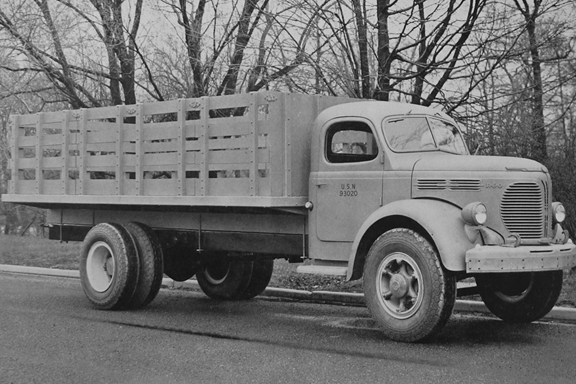
Reo built 438 5-ton stake trucks for the U.S. Navy. This is U.S.N.
registration number 93020. Photo added 12-29-2020.
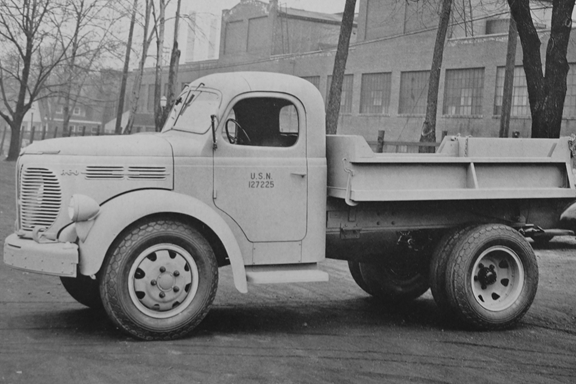
This is one of 594 1-1/2-ton dump trucks that Reo manufactured for Navy
use. This is U.S.N. registration number 127225. Photo added
12-29-2020.
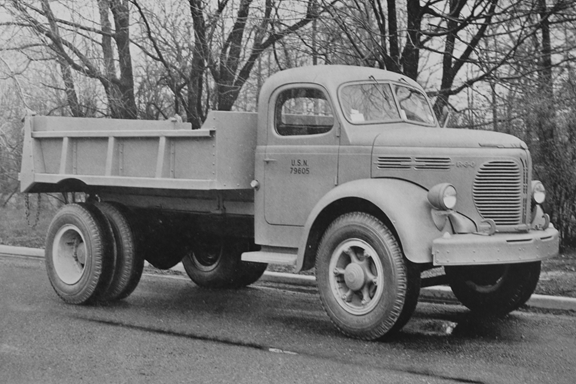
U.S.N registration number 79605 is one of 300 5-ton dump trucks
Photo added 6-28-2018.
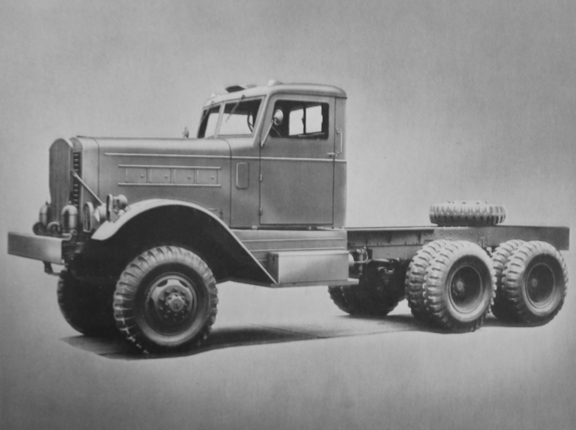
Reo built 200 10-ton 6x6 salvage trucks for
the U.S. Navy. Photo added 12-29-2020.
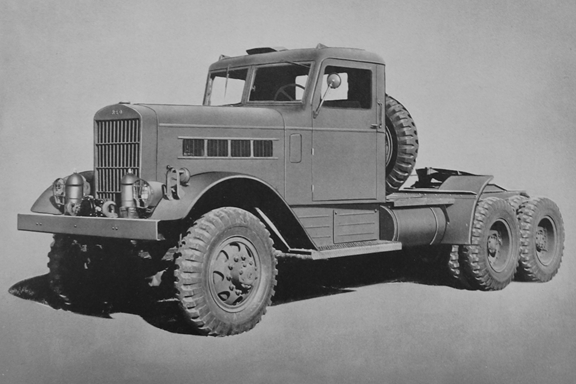
This Reo 29XS, powered by a Hercules HXD
engine, was used to pull USAAF fuel trailers. Reo built 1,740 of
them in this configuration. It built another 758 for use as fire
trucks. Photo added 12-29-2020.
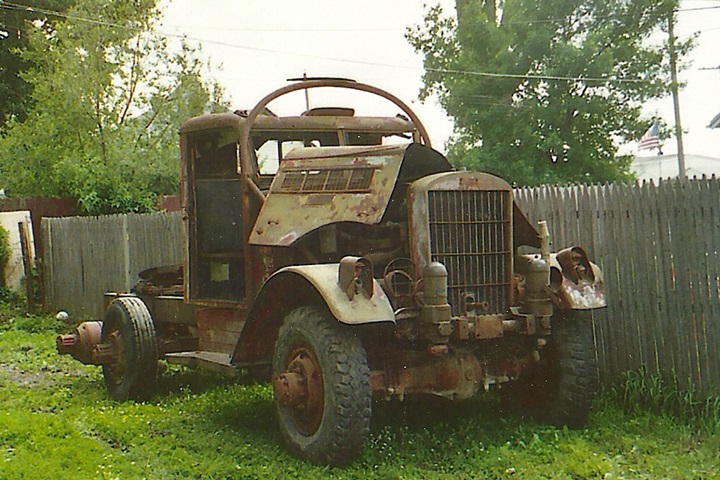
Jeff Lakaszcyck photographed this
surviving Reo 29-XS in 2004. Photo added 1-17-2021.
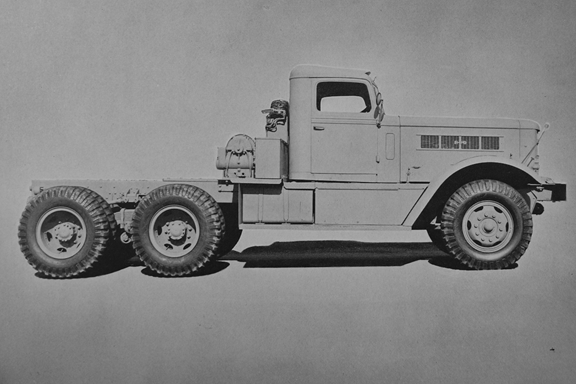
Reo built 700 28-XS 20-ton
tractors, each powered by a Cummins HB600 diesel engine. Photo added
12-29-2020.
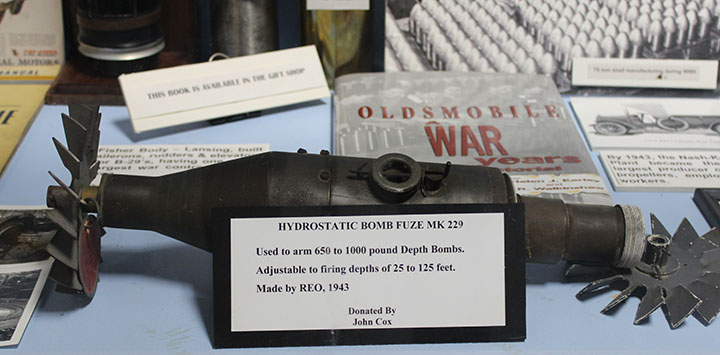
This Reo-built Mark 229 Hydrostatic Tail Fuze was used by the US Navy during World War Two in its 650 and 1,000 pound depth
charges. Reo built 100,933 of these through July 1944. The fuze
is 16.33 inches long with a diameter of 3.25 inches, while the sixteen
blade arming vane is 5.25 inches in diameter. Depth settings were
made by a hand dial on the device and could be set for 25, 50, 75,100
and 125 feet. The small hole on the left end of the body was used
to insert a pin into the device to disarm it. Reo did not arm
the fuzes it built. The fuzes were inert when they left the factory.
The units were armed at another location. Author's photo from
the RE Olds Museum in Lansing, MI. Added 4-30-2015.
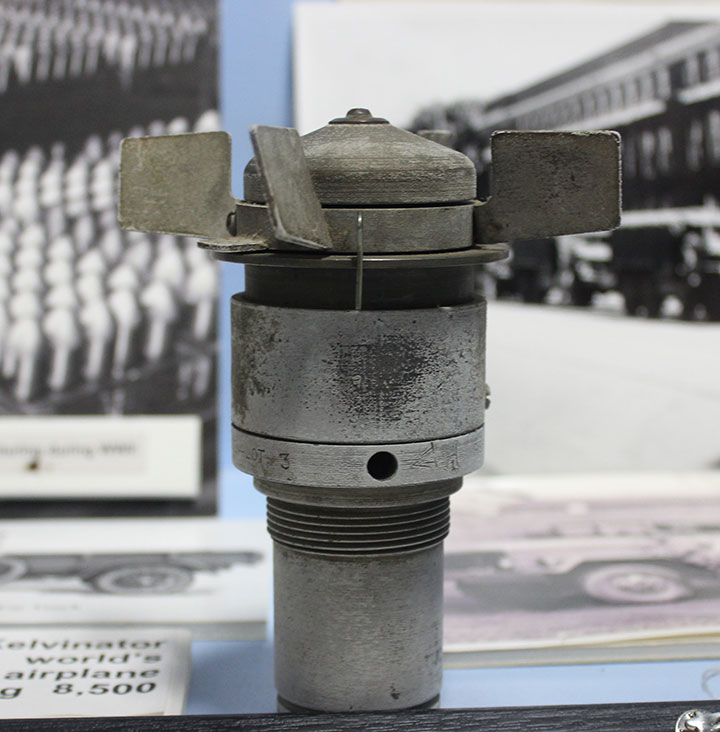
Also, another Reo-built depth charge fuze is on display at the R.E. Olds
Museum. Note the pin that keeps
the vanes from spinning and maintains it in a safe mode. Author's
photo added 4-30-2015.
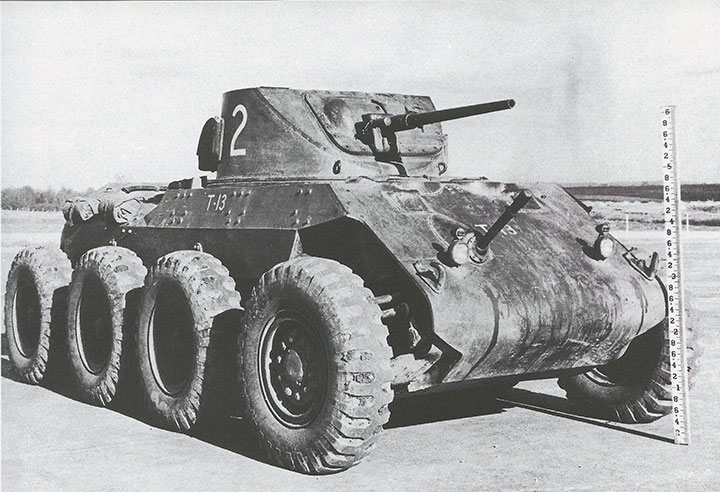
This Reo-built T13E1 was one of two
prototypes built by the company under contract from the Trackless Tank
Corporation. The first was completed in May of 1942, and along
with the second prototype was shipped to Fort Knox, KY for evaluation.
Testing resulted in the cancellation of the project.
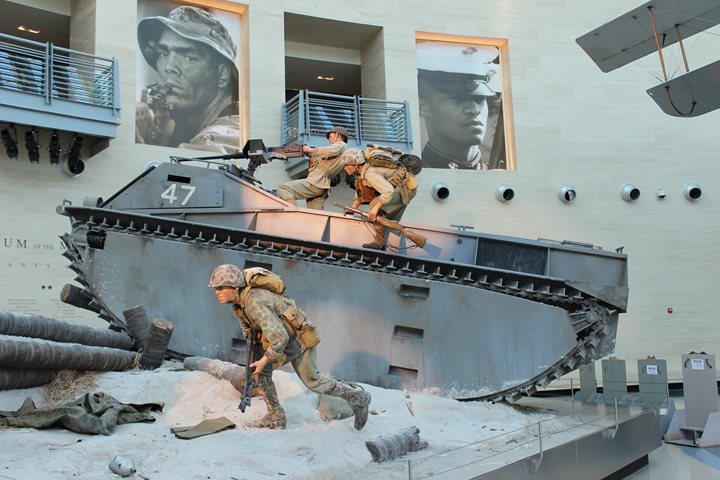
This diorama at the National Museum
of the USMC depicts an LVT-1 going over a log barricade at Tarawa.
Reo built 41,920 bogie wheel assemblies for vehicles like this. Author's photo added
6-28-2018.
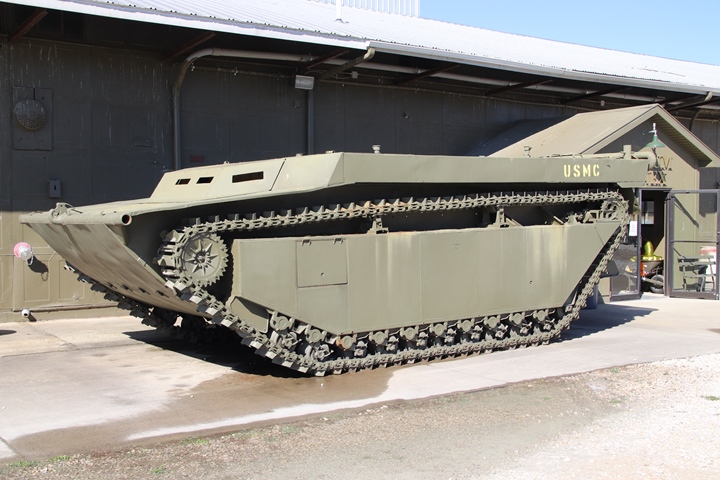
This is an LVT-4 that is on display at the Indiana Military Museum.
Each LVT-4 had 20 boogie wheel assemblies. Author's photo added
10-1-2021.
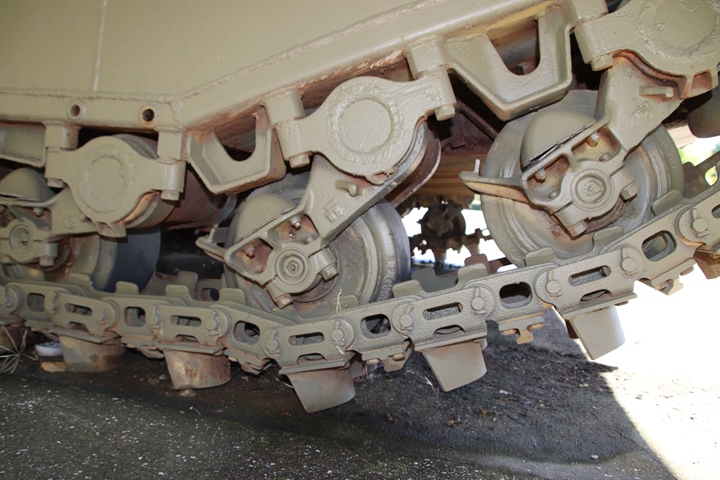
This photo shows the boogie wheels
assemblies like Reo built during World War Two. Author's photo
added 10-1-2021.
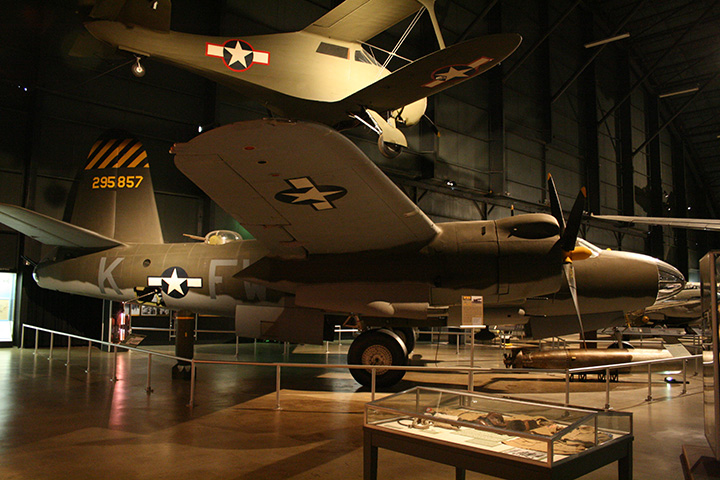
This Martin B-26 is on display at the
National Museum of the United States Air Force.
The Hudson Motor Car Company built rear fuselage sections for this type
aircraft and shipped them to Martin's plant in Omaha, NE. Reo
produced tail assembly spars for Hudson.
Author's photo added 4-3-2020.
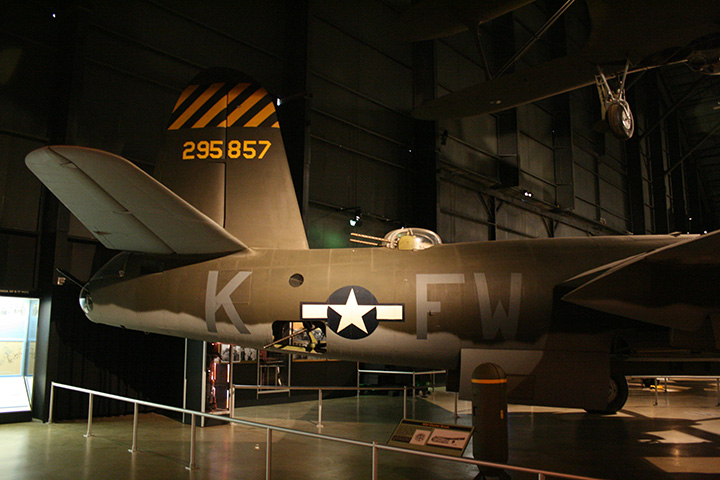
The rear fuselage of the B-26 was the section Hudson made for the Martin Omaha
plant.
Author's photo added 4-3-2020.
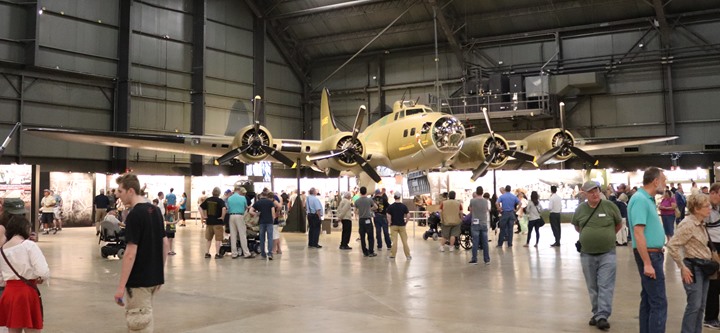
Murray Corporation built B-17F outer wing
assemblies under contract from Douglas Aircraft.
Murray contracted some of the work for the outer wing assemblies to Reo.
Author's photo added 4-3-2020.
The Plant:
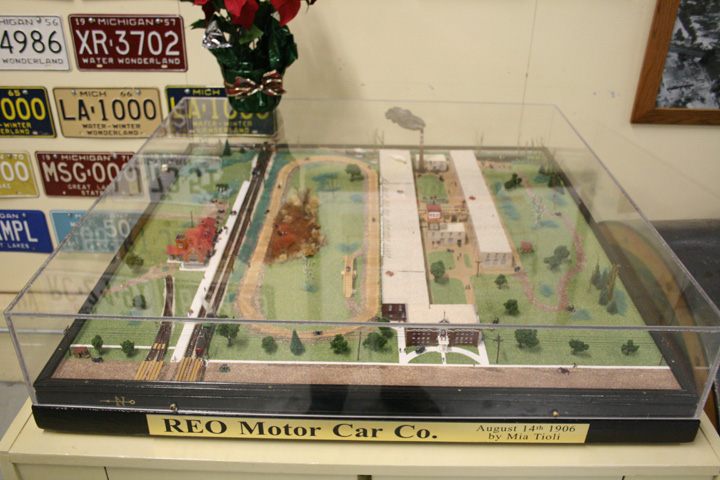
Mia Tioli made this excellent looking model of
what the Reo Plant looked like in 1906. In the end, most of the
green space was covered with factory expansions. The road along the
bottom is Washington Ave. During the mid-sixties, I used to walk this section of Washington
from my house to the downtown area which would be to the left or north. I remember trucks, and especially Army 2-1/2-ton 6x6 and five-ton 6x6 trucks, coming off the assembly line, no doubt on their
way to Vietnam. In the lower right hand corner, which would be the
intersection of Baker Street and Washington, the City of Lansing had a
firehouse with a Seagrave engine. On the site where the west side of
the test track is located, the Reo Clubhouse was later built.
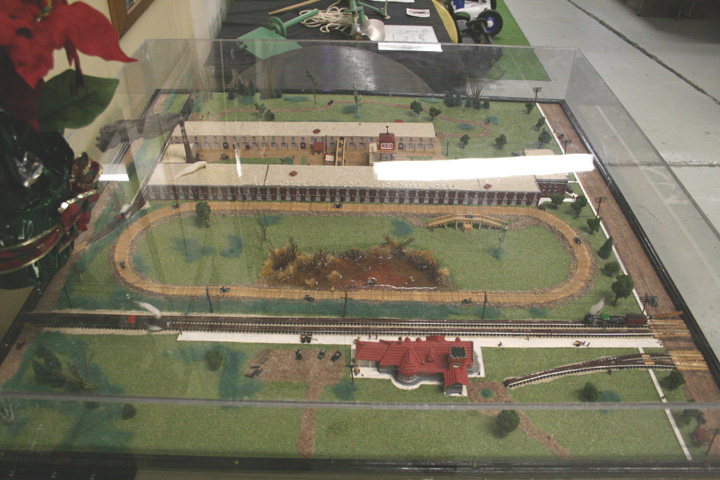
This view is looking south with the Lansing railroad
station for the Grand Trunk Railroad. Now you know where Grand Funk
Railroad got its name. Author's photo.
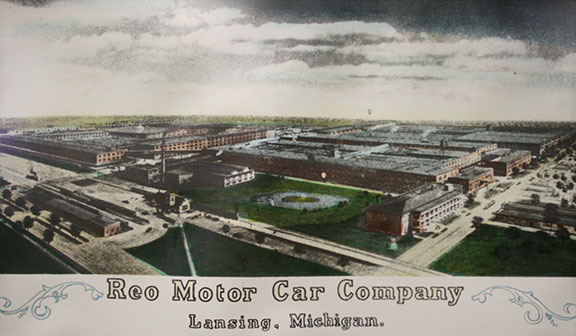
The Reo Complex looking southeast at a later date
than the model above. The Reo Clubhouse has been built and is on
the northwest corner of the property along Washington Avenue.
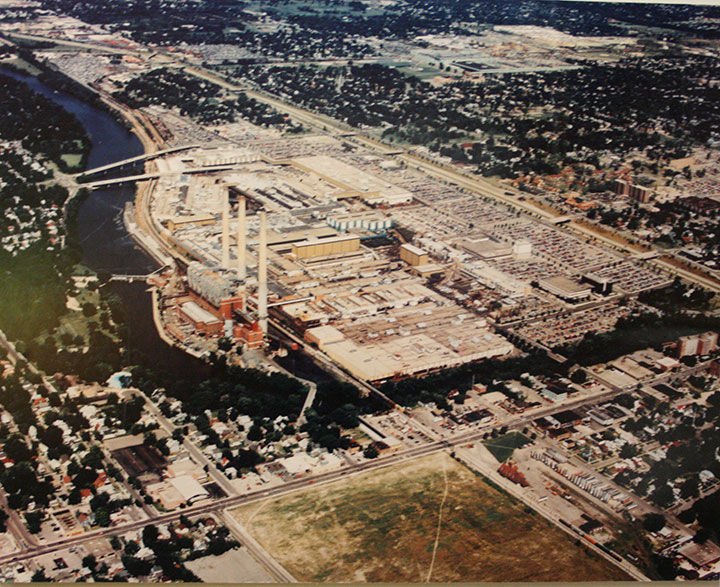
This is a post-1979 photo, looking northwest
at the Oldsmobile Complex in Lansing, MI. while at its apex. Much of it has now been
torn down. In the background, one can see the Fisher Body /
Olds Forge / Olds Jet Plants that have also been razed. Also visible is
the former Lansing Sexton High School that I attended. Of
interest, from a Reo prospective, is the empty field in the front center
of the photo, as this is where "The Reo" stood. Since
this photo was taken, the area has been made into an industrial park.
The red building to the right (north) of the former Reo complex is the
train depot that can be seen in the model above.
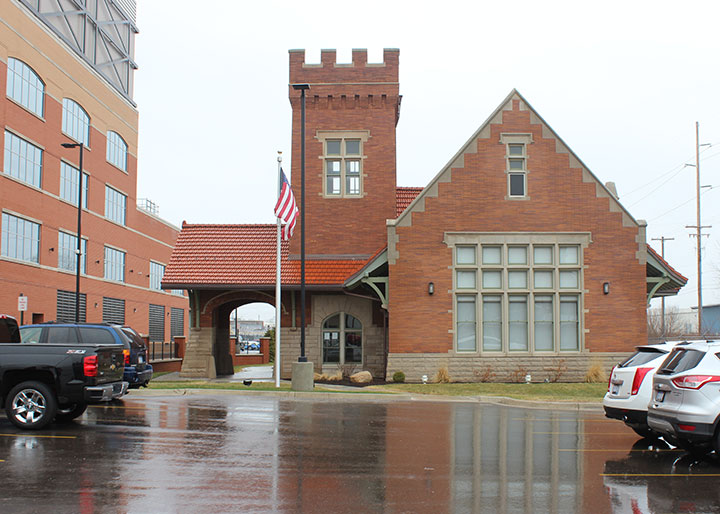
The train station still stands, even though
the Lansing Board of Water and Light has built a new building just to
the north of it. Someone had the presence of mind to make sure
there was room for the structure. It will outlast all of us!
Author's photo taken on 4-8-2015 and added 4-30-2015.
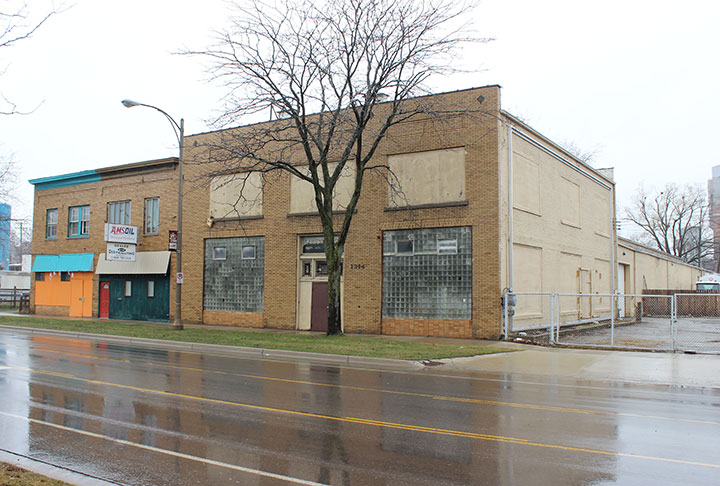
This is the last and only Reo building still in existence, as seen in April
2015. Author's photo added 4-30-2015.
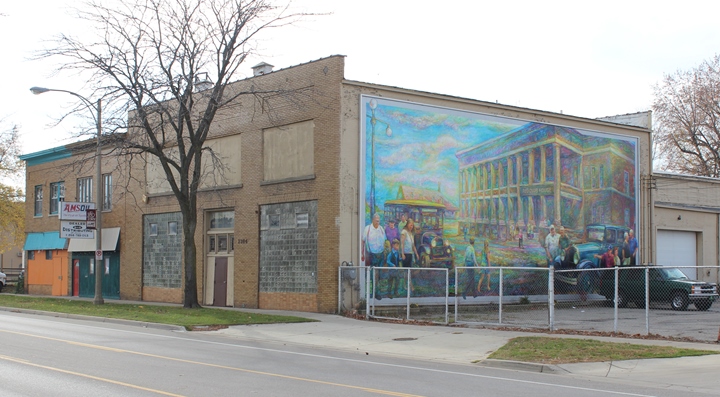
The former Reo Showroom on South Washington
Ave., as seen in November 2015. Artist Tony Hendrick painted this
mural attached to the building in 2015. Author's
photo added 11-25-2015.
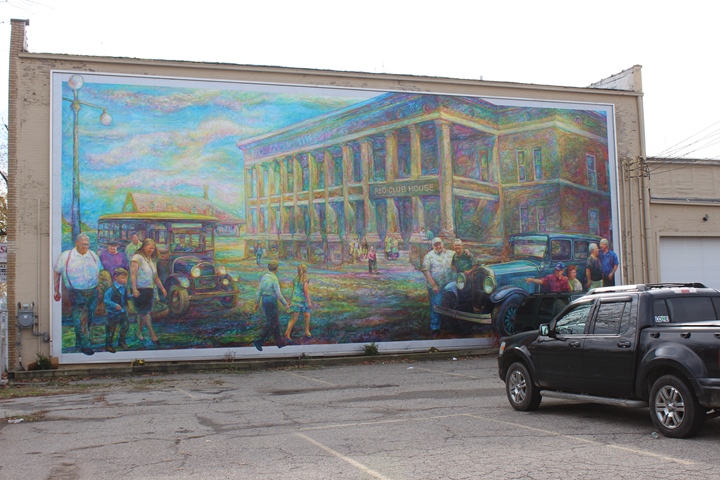
Author's photo added 11-25-2015.
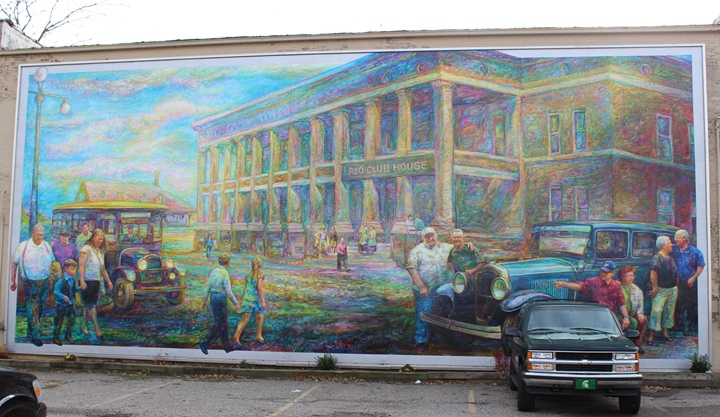
The building in the mural shows
several former Reo employees with the now razed Reo Clubhouse in the
background. In its prime, the Clubhouse was a gathering place for
Lansing residents to come and listen to concerts and participate in
parties and dances. Author's photo added 11-25-2015.
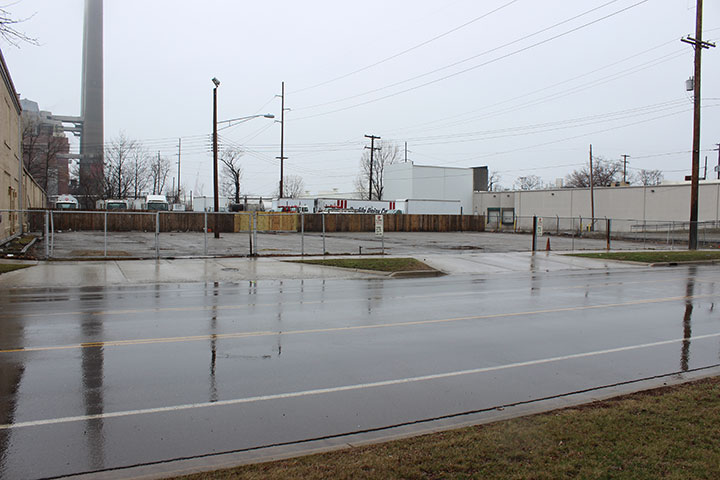
The former Reo storage lot. This is
where the last two photos were taken in November 2015. Author's
photo added 4-30-2015.
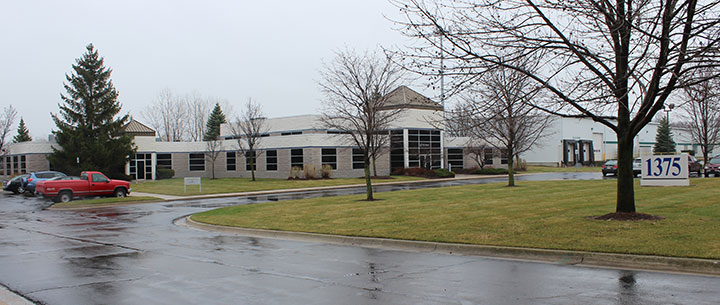
Today this new building occupies the
location of the former Reo Clubhouse in the Reo Industrial Park.
Author's photo added 4-30-2015.
World War I:
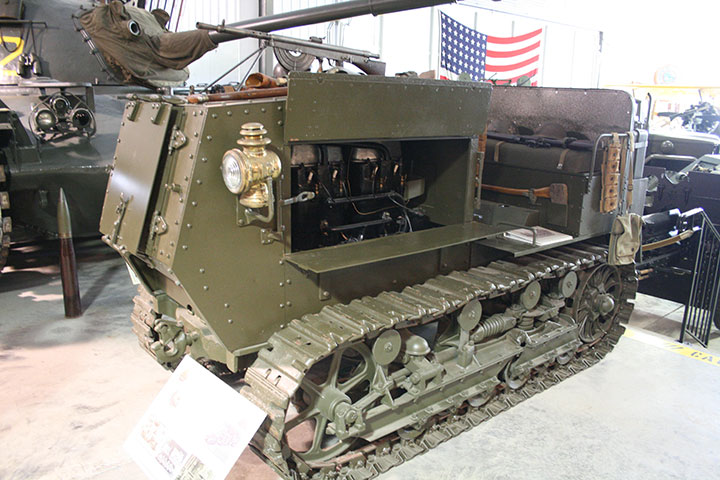
This militarized version of the Holt Tractor
was built by Reo in 1917 as a 5-ton prime mover for artillery in World
War One. It was photographed at the former Ropkey Armor Museum in Indiana. The
museum is now closed; and the location of the tractor is unknown. The
Tractor has a 45 hp engine. Holt later evolved into Caterpillar.
Author's photo.
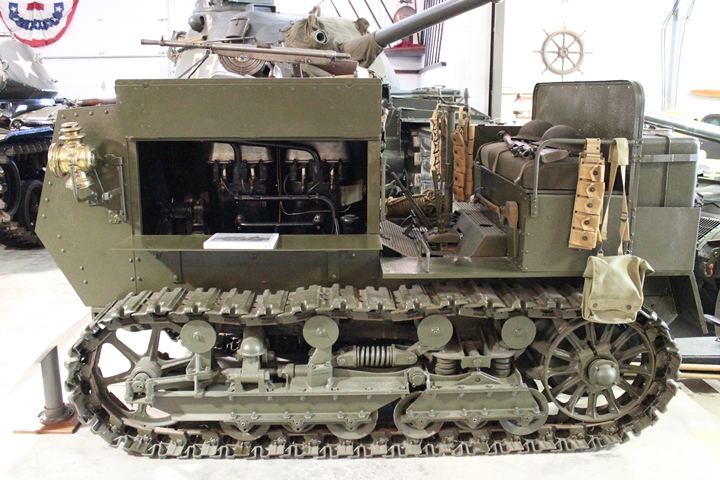
Author's photo.
Post-World War World War Two:
During World War Two, Reo built Studebaker-designed US6
2-1/2-ton trucks for the war effort. In 1949, Reo designed
and built 5,000 2-1/2-ton 6x6 six-wheel trucks designated as the M34 and known
for a while as the "Eager Beaver," due to its ability to ford rivers and
streams. The M34 was quickly replaced by the 2-1/2-ton 6x6 10-wheel M35 that was
produced by Reo, Studebaker, Kaiser-Jeep, and AM General from 1950 to 1999.
It was known to the troops that used it as the "Deuce and a Half."
This design replaced the
WWII GMC CCKW in service. The original M34/35 series was powered by a
Reo-built 331 cu. in. 6-cylinder Gold Comet Engine.
Below is a photo of seven of the 5,000
M34 6x6 2-1/2 ton trucks built by Reo. This photo was taken in
front of the Reo office buildings looking north-northeast along
Washington Avenue in Lansing. These can be identified as the M34,
as the trucks only have single tires on each end of the rear axles and
the clearance cut-out over the tires in the bed.
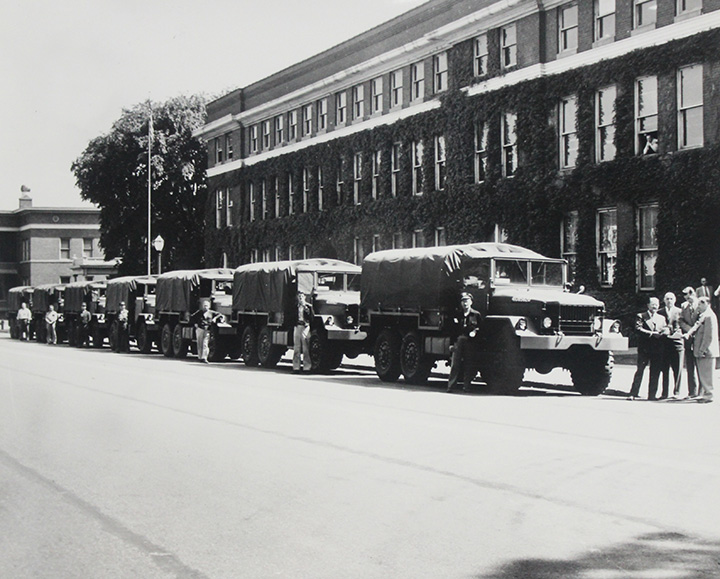
Photo added 4-14-2015.
After the Korean War was over, Reo lost the
contract to GMC, which had a lower cost structure and its own design
designated M135. Later Reo, as part of White Motors and Diamond Reo,
produced M35s for the Vietnam conflict. As
an interesting aside, as noted above, Reo built Studebaker-designed 2-1/2-ton
6x6
trucks during World War Two, and Studebaker was building Reo-designed 2-1/2-ton
6x6 M35s when
it went out of business in 1963. (See my Studebaker page for a
photo.)

A Lansing, MI-built Reo/White M35 2-1/2-ton
6x6 truck is seen here at the James Dean Festival in
Fairmount, IN.
Since the beginning of this website over a year ago, I have been
searching the military events to find a Lansing-built M35. Of
all places, I find it at a vintage car show 25 miles from my house.
Author's photo added 10-5-2014.
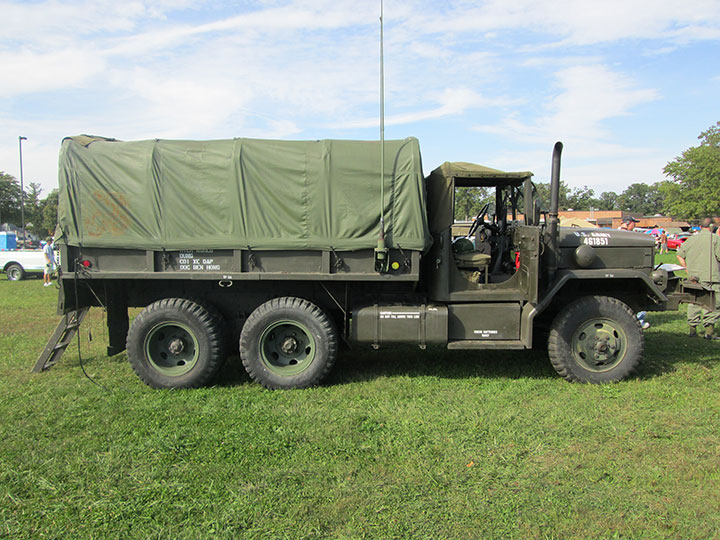
The reason for the Lansing Reo M35 search
is that growing up in Lansing in the 1950s and 1960s, I used to see
these trucks come off the end of the assembly line. Often, I would
see them being test driven on Washington Ave. As I walked by the
plant during the 1960s, I knew that these trucks were destined for Vietnam.
Author's photo added 10-5-2014.
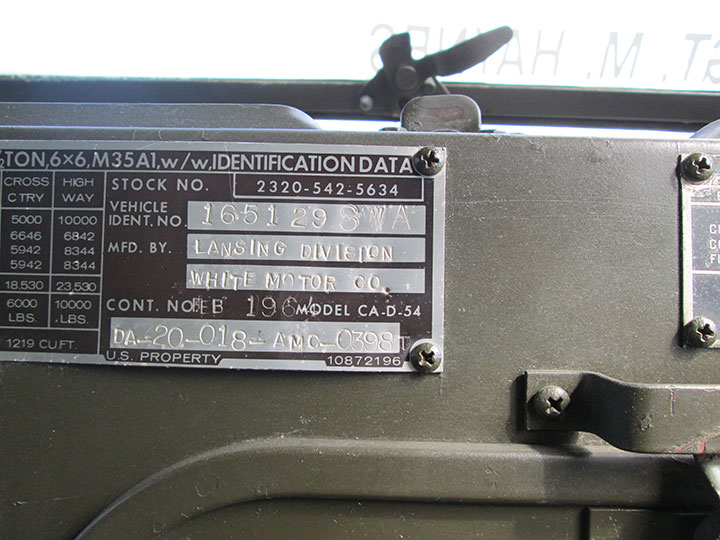
White Motor Company bought Reo in May of
1957 and Reo became the Lansing Division of White Motors. So, while
the name tag says White Motor Co., the plant was still
known to us locals as "The Reo". In any event, this
truck was designed by Reo in 1949 and assembled in the same plant 15
years later. They were still Reo trucks. This M35A1 was built in February
of 1964. Maybe I saw it come off the end of the assembly line on
Washington Ave. as did many of this type.
Author's photo added 10-5-2014.
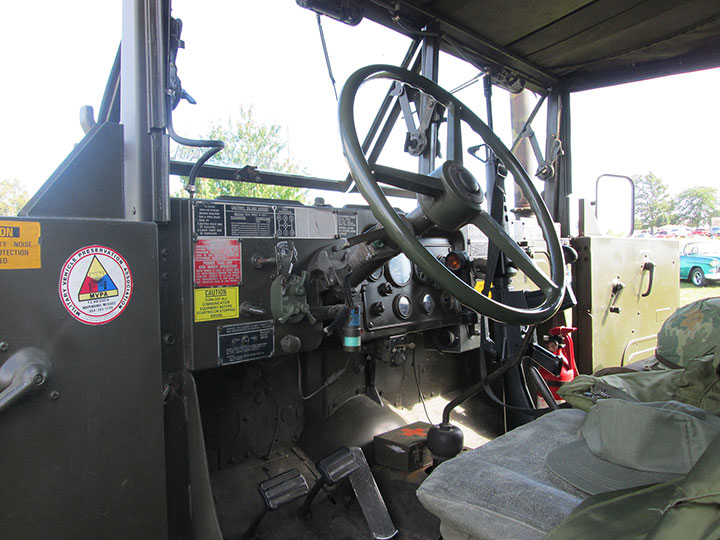
A year after White purchased Reo, it then purchased the Diamond T Truck
Company. One of the immediate benefits to Reo is that its OH185 V8
engines were then supplied to Diamond T. In 1960 White moved the
Diamond T operation from Chicago to Lansing and built both truck lines
in the plant until 1967 when the two truck products were combined into
one product line, Diamond Reo. Author's photo added 10-5-2014.
REO Produces for War

 
This is the Reo Model 28XS, which is based on
the Federal 604 20-ton tractor. Most of the Reo output was for
Lend-Lease to Canada, the United Kingdom and the Soviet Union.
This is one of the few trucks built during WWII that used the Cummins
HB600 diesel engine.
 
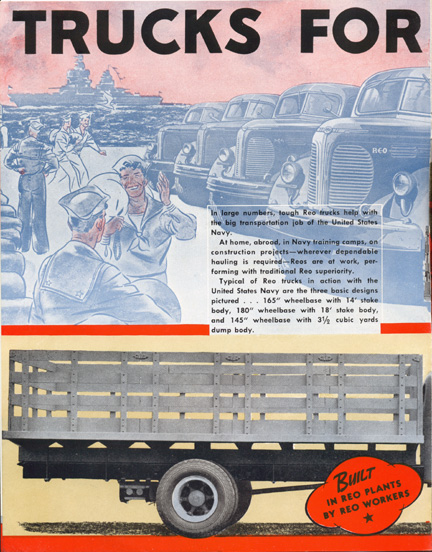 
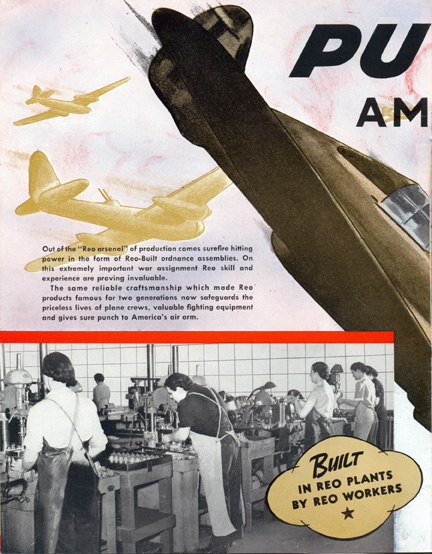 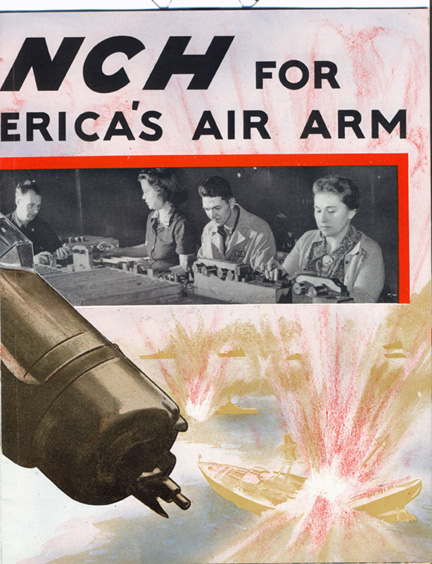
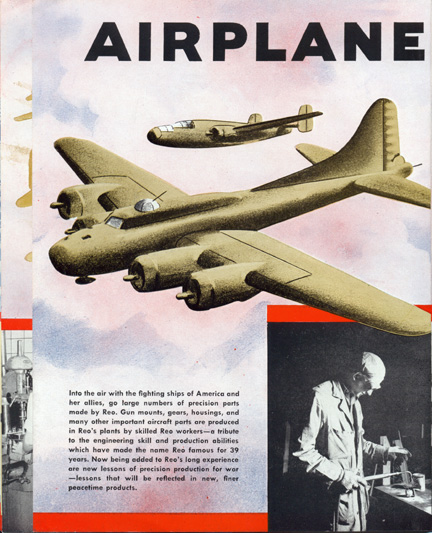 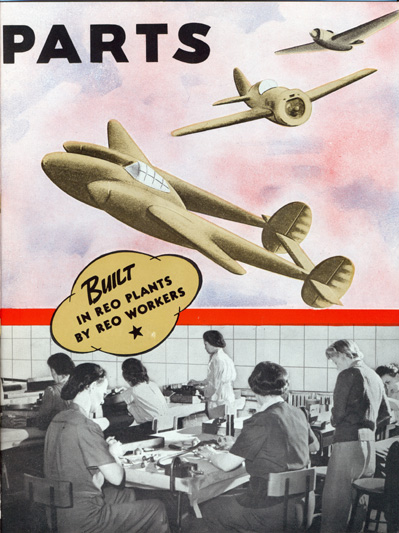
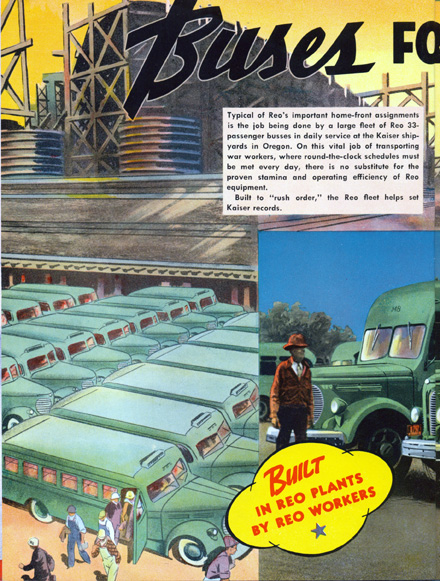 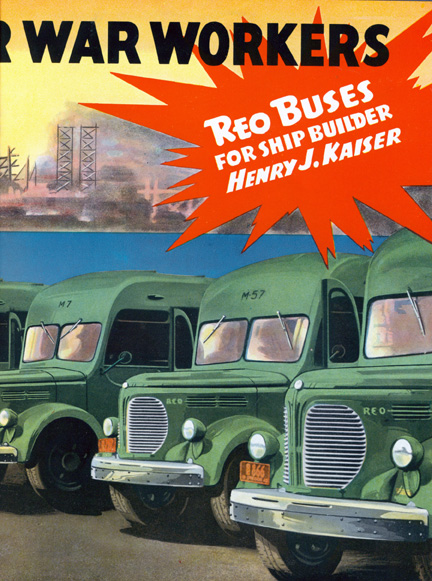
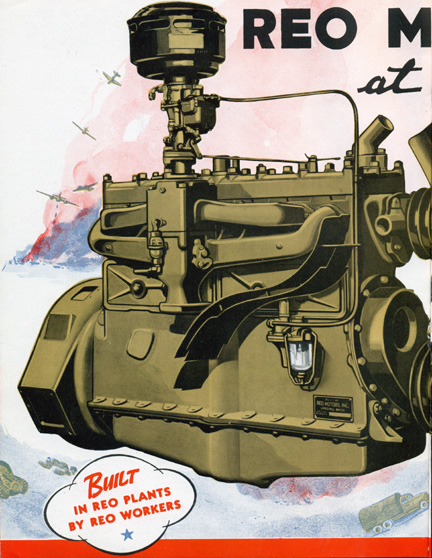 
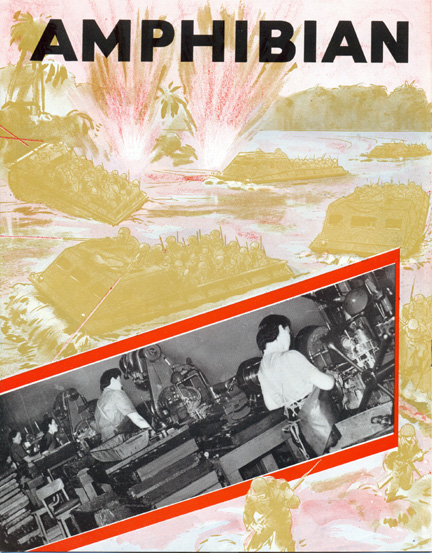 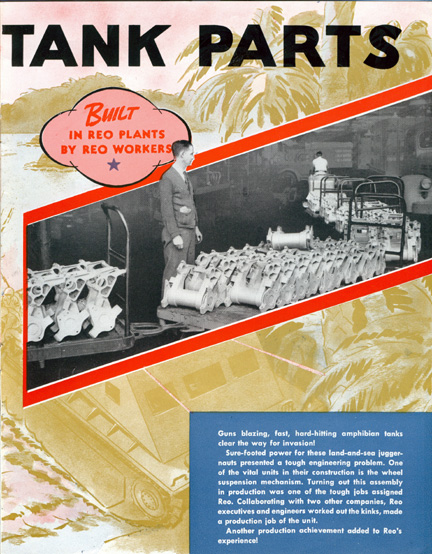
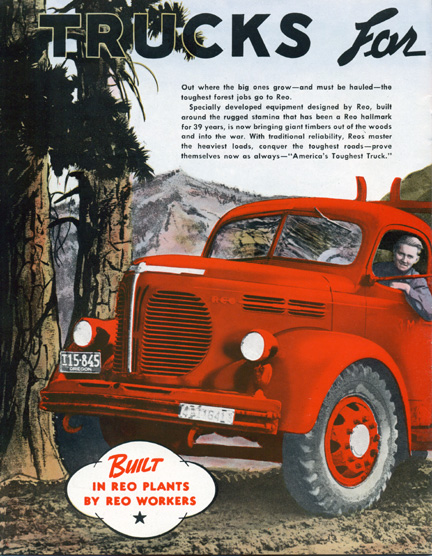 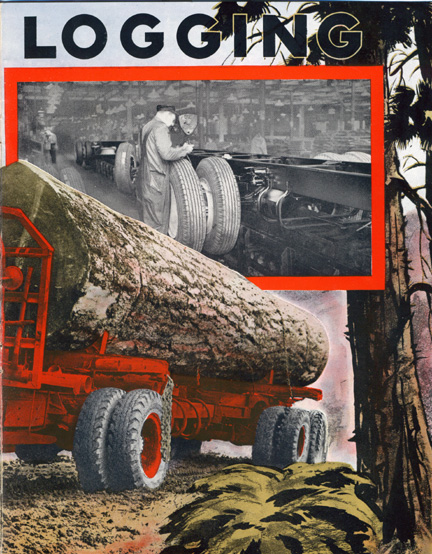
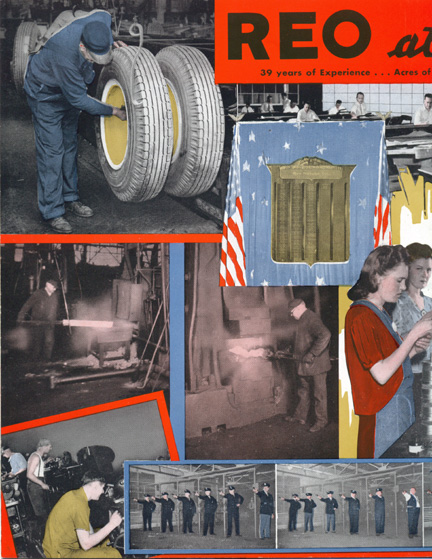 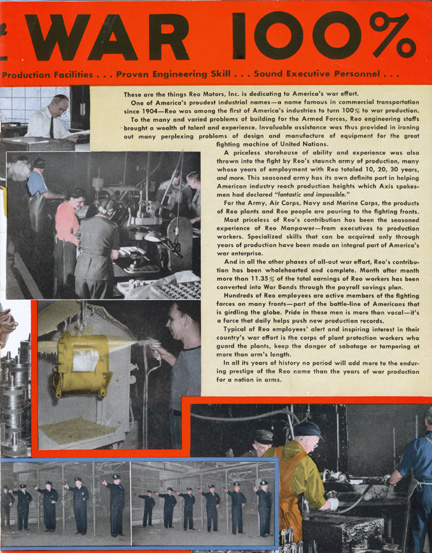
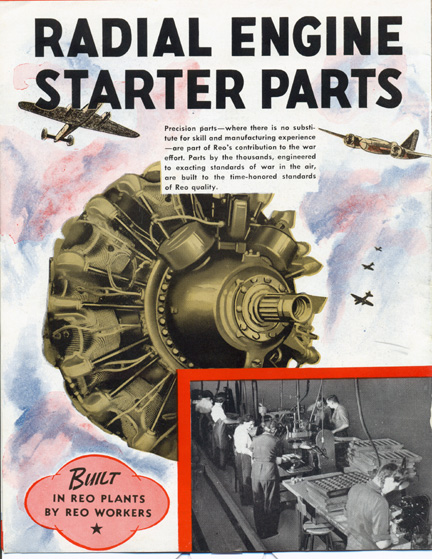 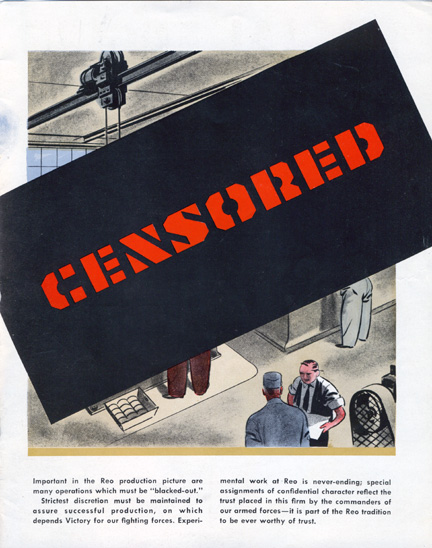
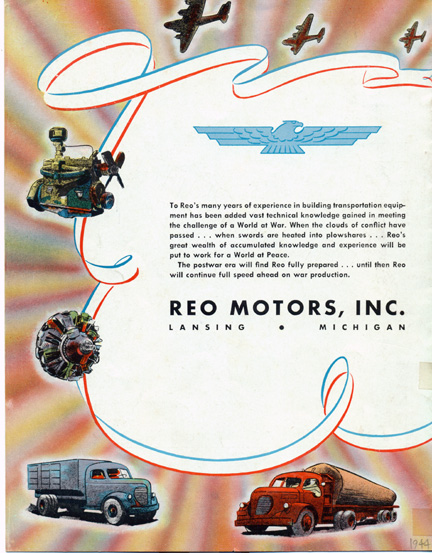
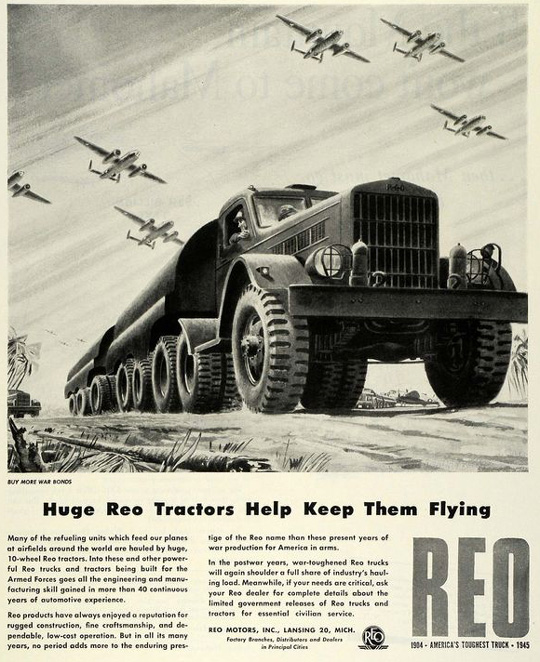
Reo
built 2,318 7-1/2-Ton 6x6 Tractors for the US Army Air Force.
Other Lansing Companies that contributed
to winning World War Two
|



















































































































